#or at least provide essential context
Text
[Post in English]
Something Nyx and I want to publicly address, regarding the recent allegations in the Glitchtale Crew's Discord Server and it's moderators.
I really apologize for the upcoming wall of text. These are our Twitter threads I have pasted them here, in case you don't have access to said platform. I have also added some additional notes to provide more context.
All details under the line:
NyxTheShield: (Transcription from his official twitter thread)
I read some mean comments lately and I just wanna be super clear: I havent been related to Glitchtale since at least 2022. I never considered myself part of the community and went through some much shit while doing stuff for it that my mental health was completely destroyed.
For people who thought I was an admin of the server, that was just in paper. I was constantly de-admin'd, demodded and kicked from the server through the years for simple stuff like asking the rest of the mod team to not say slurs or standing up against the Midnight Crew.
I personally left the server for a long while because I really did not want to be around some of the people there.
All of this happened years ago (from 2016~ to around 2020). On the early years, my full income came from Youtube/Glitchtale. I was a broke college student and my economic stability depended on it.
Despite this, and making literally hundred of tracks and hours of music for the series, most of the income came from my own ad revenue. I was paid less than 2000 USD for all of the work. Essentially, I was paid in exposure.
This wouldn't have been an issue for me if at least I got to keep my artistic vision with the series. That didn't hold true for long.
From the second season and onwards, and in multiple instances, I would score the entire OST for the episode, watch the episode when it released, and then find out a completely new section of the episode (usually a battle scene) with music from somebody else
This was completely demotivating to me because I wasn't being paid, the tracks would not fit the rest of the OST at all, and most of the income I made from the battle scenes.
I had to work for weeks trying to compose music for glorified powerpoint presentations (Basically everything that's not a battle scene on the series was just still frames of characters barely moving) and do all the heavy lifting and I wasn't even let known about the guest tracks.
This added to the feeling of having absolutely no power within the community. I don't know if this was intentional or not (I don't wanna presume malice), but all of these things together contributed to me distancing myself from the community.
Honestly, there is A LOT more shit that went down these early years that are extremely traumatic to me that I would prefer to not talk about unless completely necessary, but I feel this is a good amount of context for what I wanna talk about next.
As you might be aware, extremely serious (and true) allegations were made against Camila and his partner, Veir, which was accused of grooming minors from 2015 to 2021
There are really good videos out there explaining the entire timeline of what transpired, but I specifically wanna talk about 2020.
(Jakei's note: Links to said videos are here: [1] [2] [3])
In that year, a public document was made by my head mod CrystalFlame alongside 2 other mods in the GT server, that exposed Veir and their actions. This document went mostly unnoticed.
Even more, Crystal went through a lot of abuse for coming forward about their abuse and was almost ostracized from the UT AU community because of this.
Because of this, I was asked directly by one of the victims (and also representing the other victims) to please not speak up (Citing that they just wanted to move on and didn't want to involve themselves with more problems and expose themselves)
All the info was kept very vague from me, including the people who were involved, the extent of the stuff that went down, etc But I knew enough to know it was serious.
I followed their request and didn't speak up publicly about this, but I banned Veir from my server, warned all of my mods and people close to me in those circles about Veir, and constantly tried to get Camila to please adress the situation.
Despite this, she did not listen and we all know how stuff went down later in 2022, where the allegations came back again with full force. This time around I wasnt asked to stay silent so I spread the word around and confronted the entire mod team. I was shortly banned after that.
I needed to address this because this thing has been eating me alive for years. I was intentionally kept in the dark about a lot of context and nuance that would have completely changed my mind about speaking up or not about what happened in 2020.
Everything is easier in retrospective, and with the knowledge I now have about the situation I know for a fact that I would have spoken up about all that happened. But being asked directly to not speak up by the victims was something that goes against what I am
Sorry for the long rant, but I really needed to get this off my chest. I am tired of having to deal with this kind of stuff. As a content creator/public figure I am trying my hardest to keep the communities I am active in as safe as possible.
I feel I could have done more for the Glitchtale community regarding the grooming situation, but all of the years of abuse that I endured really fucked up my judgement. I am not very good at dealing with people and I always trust the people close to help me for this kind of stuff
Sadly, in this case, those same people who were close to me were also the victims, so they couldnt have known or had a way to help me out, I should have helped them instead.
Most if not all of what was described in this thread is backed up by screenshots, chat logs, and direct testimony from the people who were involved during this time.
I don't want to direct hate to anyone or start a witchhunt, I am doing this purely to decompress a bit and try to vent some of the trauma I experienced all these years.
============================================
Jakei: (Transcription from my official twitter thread)
I would also like to share my experiences about my relationship with the Glitchtale Creator, Camila Cuevas. Publicly, we appeared as close friends, but in reality, that friendship was based on bullying and mistreatment, and this affected my mental health deeply.
Years have passed, and the memories still cause me pain. I decided to remain silent, but after the revelations of grooming cases in her community, I realized I wasn’t being too sensitive. The time has come to speak up about my experiences.
During the early years of Underverse, I was dealing with a serious depressive episode. Simultaneous internal and external pressures as an independent artist amplified my mental strain.
Meeting Camila felt like finding a genuine friend who shared my passion for the fandom and understood the struggles of being a content creator amidst toxicity.
At my lowest, I became compliant to doing things that I didn’t want to, just to keep people around me happy. For Camila, this meant allowing her to belittle my work and make me the butt of her jokes.
Only our veteran followers may remember the 'roasting games' between us on Tumblr (consisting of mutual insults), a spectacle where she'd always win. However, it was a game she privately forced me to "play" and I ended up accepting, despite the discomfort it caused me.
These 'games' would give her a cool and strong image in the fandom while painting me as the dumb, 'cringe-worthy' friend. In essence, I became her personal punching bag, unknowingly reinforcing his reputation.
Camila's favorite term to demean my series 'Underverse' was “Cancerverse”. It felt like a constant contest where she'd always position herself as the superior writer and animator simply because my story and animation techniques didn't fit her standards.
Years of being subjected to her ridicule left my self-esteem in ruins. I was okay with the negative feedback by some fans, but when my 'friend' publicly disrespected my art, it made me question my abilities as an artist.
I can't deny there were times when she gave me advice to deal with hate or hurtful comments. However, her damaging comments and treatment outweighed those moments of support.
My depressive state worsened around July 2017, where I had accepted people pushing me to do things I wasn’t comfortable with, while being part of Camila's demeaning games, just to appease her ego.
I was introduced to Nyx during this time, he offered his music for my series, and eventually we started dating. We met in person in Chile, where I also met Camila. I hoped our friendship would strengthen but everything felt the same.
Before I moved to Chile with Nyx, Camila reached out to me in dms, attempting to turn me against him because he opposed the use of slurs in the GT server. She claimed Nyx was being 'brainwashed' by his American friends belonging to the black and LGBTQ+ communities.
She made fun of my dating choices, suggesting I was entering a toxic relationship, while showing off her relationship with her then-boyfriend (later exposed as a pedophile).
She even quoted her own mother assuring me that Nyx would 'get back to normal', and if it didn’t happen, she would let me live in her house, almost like if she was telling me that Nyx would hurt me or make me feel miserable.
It only took Nyx 3 months to realize that the GT server was going in the wrong way. I initially felt compelled to defend Camila due to my inferiority complex, but soon realized Nyx was right.
(Jakei's note: Not only Nyx was right, a lot of people that called her out over the years were right, yet they were not listened to at the time)
Even then, I found it difficult to distance myself from Camila due to the false sense of obligation I felt towards her. My fear of her making fun of my work kept me from interacting with others in the short period of time I stayed in her Discord server.
I was afraid that she and her echo chamber would talk behind my back, something that I found out was happening in private chats until recent years.
Rebuilding my self-esteem wasn't an easy task. I began noticing the red flags – Camila's lack of respect not only for me but Nyx also, the emotional manipulation Nyx was suffering from Veir (something he used to do all the time with his other victims), her attempts to 'roast' me in front of her family and fans in the Underverse/Glitchtale meetings, and her constant criticism of my artstyle not being compatible to hers in the few collabs we made.
All these 'small' instances, dismissed as insignificant by many, caused me immense pain while treating my depression. I felt it was too late to express how I felt, as I feared being labeled as attention-seeking or oversensitive by her and her fanbase.
Ironically, the moment she talked about her traumas after being bullied in the past, her feelings were the only ones that mattered any time she was involved in a problematic situation in the fandom and deserved to be the only to get pats in the back.
I never expected a sincere apology, as I was convinced she didn't remember or didn't care about the hurt she caused. I tried to maintain a facade of good terms with her, both publicly and privately.
Eventually, I distanced myself from her, unfriending her and banning her from my own server even if she didn't interact there. I started focusing on my own work and the people who appreciated it. Despite this, the aftermath of the bullying continued to affect me.
Everything fell into place when the grooming accusations against her former boyfriend and server mods came to light. It was a shocking revelation, but it validated all my doubts and fears about her.
The purpose of sharing my experiences is not to stir up drama, but to address the concerns of those worried about my association with Camila. I want to make it clear that I will never tolerate such behavior.
Although the things I did for her in the past cannot be erased, I hope Camila at least deletes the animation remake I did for her and all the collabs that boosted her views for free, though I'm not optimistic about it happening.
As I've matured, my hope is that she and her crew learn from their mistakes, start behaving like adults, and take responsibility for their actions in their future projects and with their new followers.
But I'm skeptical about any real change, especially if their server continues to exist. The best course of action for me was to cut all ties with Camila and Glitchtale.
NyxTheShield (now my husband) and I have endured too much from our treatment by Camila. We no longer want to be associated with her or Glitchtale. It's a chapter of our lives that we wish to close.
It's time for us to focus on recovering our mental health, as remaining silent is only prolonging our pain. We have been working to improve our mental and physical health over the past few years and this is a crucial part of our healing process.
2K notes
·
View notes
Text
Let's Talk About Baeddels.
An (updated) retrospective on Tumblr's movement to make gender essentialism trans-friendly.
This post contains excepts from a longer article on Medium. If you have the time, please read the full article! I also request that you link the longer article if you use this as a source.
All links have been updated with archived versions of posts that have since been deleted (and otherwise might be deleted or lost sometime in the future). I have revised some sections, and included more context and examples, in order to clarify and strengthen arguments.
Disclaimer
Transmisogyny is real, and requires much more acknowledgement than it currently receives. The trans community is very much capable of transmisogyny, and often does enact or enable it; likewise, trans people also often enact and enable transphobia against other parts of the trans community. Trans women suffer at least as much as the rest of us, and trans women — as a class — are not privileged, and do not hold the power to oppress anyone else.
If you take only one thing away from this post, take this:
Trans people all need to work on being better allies to each other. None of us can gain anything without the rest of us.
Establishing an Ideology
The first post on Baeddelism was by Tumblr user @unobject, on October 2nd, 2013:
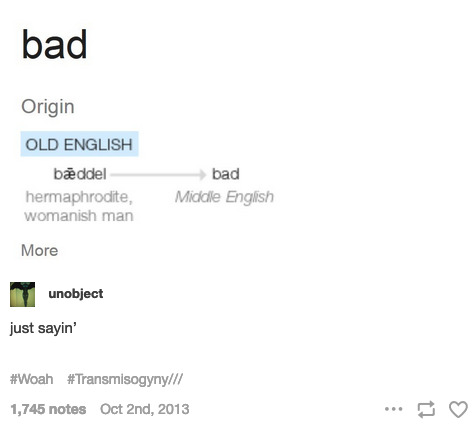
The post was quickly liked by @lezzyharpy, also one of the first to call themselves “Baeddels”.
This post first provided the name and defining ideology of the Baeddel movement. The implication of the post was, essentially, that because the root of the word “bad” was “baeddel”, and because “baeddel” referred to intersex people and “womanish men”, this old English slur was proof that transmisogyny was the worst form of bigotry; and even, perhaps, the root of all bigotry. (It’s worth noting that this interpretation of the etymology has been problematized.)
While @unobject was the first person to make this connection, @autogynephile (“Eve”) eventually became, in essence, the figurehead of the movement. Of the other Baeddels, some of them were explicitly aware and supportive of the ideology behind Baeddelism, some of them were young or newly-out trans women seduced by the personalities involved, and some of them were tangential enough to the movement that their understanding of it was wholly different from the understanding those at the core of the movement held and promoted. Baeddelism was a sort of trend, for a time, and many participants wore the name without entirely knowing what it meant.
It’s important to acknowledge that as much as there were dedicated members of Baeddelism, and as much as there was a unified ideology behind it, there were also individual Baeddels who did not understand — let alone support — the ideology.
The Ideology
Baeddels essentially built upon the foundation of @monetizeyourcat’s ideology that had been gaining traction on Tumblr in the years prior, with some additions that ultimately defined their movement:
Transmisogyny is the form of oppression from which all (or most) other forms of oppression stem.
Privilege is granted on the basis of assigned sex. (“AFAB” or “Assigned Female at Birth” vs. “AMAB” or “Assigned Male at Birth”)
These fundamentals of Baeddelism were essentially a rebranded form of Radical Feminism. In particular, they drew from the Radical Feminist idea that misogyny was the “primary” form of oppression; that which all other oppression stemmed from. Baeddels only tweaked this idea to replace “misogyny” with “transmisogyny”, which led to the rest of the conclusions Baeddels drew:
There is no “transphobia”
All “transphobia” stems from transmisogyny first, and transphobia as it impacts non-trans-women (or, sometimes, non-transfeminine people) is incidental.
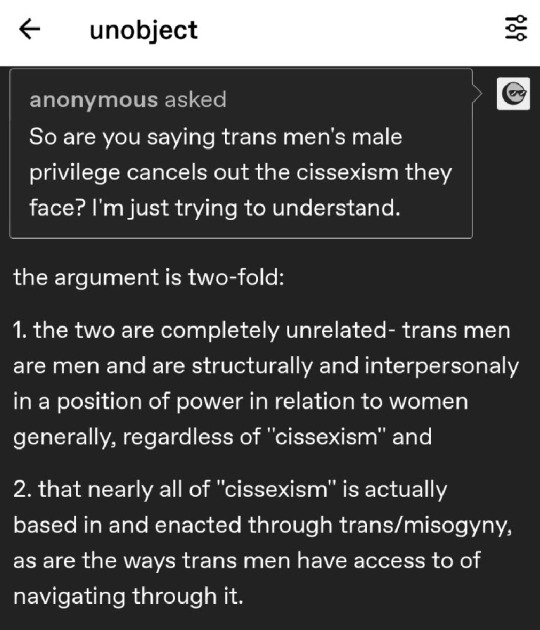
There is no “Trans”
If “transphobia” isn’t real, what else is left of the transgender identity?


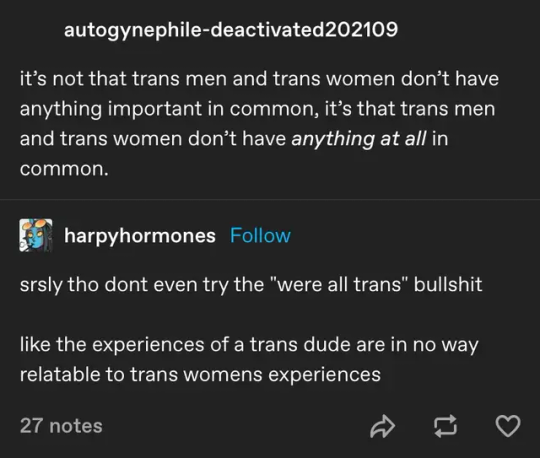
While this is by no means the dominant understanding of transgender identity or community, the equivocation of oppression to identity is, in many ways, core to Baeddel ideology (and we see the lasting impact of this in still-widely-used “TME/TMA” termingology). By this logic, if transphobia doesn’t exist, neither does trans identity or trans community (though they obviously believed that transmisogyny, and subsequently trans women, do). Therefore, there are no “trans men”, and belief in the existence of “nonbinary people” is highly contingent on whether an individual believes in the oppression of nonbinary people.
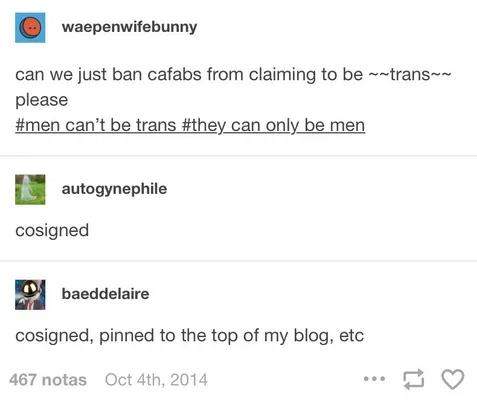
“AFAB Privilege”
The idea that within the queer and/or trans community, people who were AFAB/CAFAB (Assigned Female At Birth) receive unique privilege and positions of power that people who were AMAB/CAMAB (Assigned Male at Birth, a counterpart to “AFAB” and “CAFAB”) do not.

Trans Lesbian Separatism
… was what the movement was ultimately defined by, as the logical conclusion of their other beliefs (much like Lesbian Separatism was the logical conclusion of Radical Feminist beliefs).
Baeddels believed that only trans women can understand, or be truly safe for, other trans women; therefore, contact with anyone who was not a trans woman was deemed “dangerous” and highly discouraged.

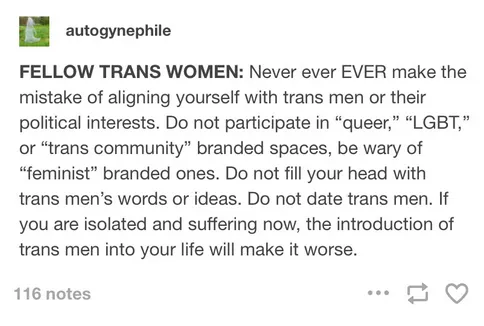
Trans Men
… also played an important role in Baeddel ideology, and the resulting treatment of trans men is what is often remembered today. Baeddels generally believed the following, either explicitly or implictly:
Trans men are not oppressed, or experience so little oppression that it hardly matters.
Trans men do not experience misogyny, even prior to transition.
Trans men have access to male privilege, or trans men have an easier time passing, and frequently go “stealth”; thus benefiting from male privilege as well as cis privilege.
Trans men are often (or always) misogynistic and transmisogynistic, and are not held accountable for this.
Trans men oppress cis women.
Trans women enacting violence on trans men is “punching up” at oppressors, and therefore not only permitted, but encouraged.
Trans men are inherently violent, or become aggressive and violent when they go on testosterone HRT (Hormone Replacement Therapy)
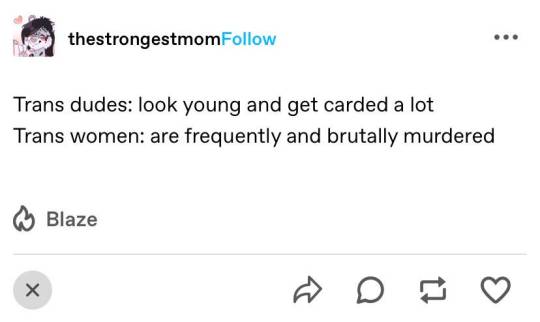





The impact of this ideology is often discussed among transmasculine people because of the depth of harm it caused, directly and indirectly — and it was very much intended to. Harm caused to transmascs was not only permitted or excused, it was often actively celebrated.

Nonbinary People
… are often overlooked when summarizing Baeddelism, but Baeddels did have plenty to say about them. Baeddel ideology relied on the idea that privilege was granted on the bases of assigned sex, and nonbinary people’s genders were thus treated as irrelevent; they essentially did not believe nonbinary people truly existed.
CAFAB nonbinary people are either trans men attempting to invade women’s spaces, or cis women pretending to be trans.
CAMAB nonbinary people are actually just trans women who haven’t accepted it yet. They must transition, or they are transmisogynistic.

Intersex People
Intersex experiences, and intersex history, were often co-opted and erased by Baeddelism. This was often more a byproduct of their beliefs than an overtly-stated idea, but most notably, the term “Baeddel” itself is likely more applicable- if not exclusively applicable- to intersex people, rather than trans women. Making their reclamation of it as a “transmisogynistic slur”, or their claim that the word’s existence means that “transmisogyny is the root of all oppression”, incredibly ignorant- if not actively harmful misinformation.
Notably, Baeddels also believed that intersex people- being “more androgynous” (a harmful misonception)- were able to pass more easily as the opposite assigned sex, and that intersex people (even within transfemme spaces) had “intersex privilege”. Some even believed, and openly claimed, that intersex people were “hermaphroditic”; a slur against intersex people, and typically implying that the individual has both sets of reproductive systems simultaneously.
Trans Women
… did not receive universally positive treatment, either. Baeddelism was very much a cult-like group built around the firmly-held conviction that they were absolutely correct, and that anyone who disagreed with them was The Enemy. Trans women who disagreed with them were generally seen as brainwashed and self-hating, and trans women who did agree with them were expected to subjugate themselves to the ringleaders of the movement.
Within Baeddel circles, trans women were most frequently victimized by the abusers allowed to run rampant because “trans women do not, and cannot, harm anyone else.” — including, apparently, each other.
“They were also bad shitty abusive people in general.
“… a bunch of them passed around a pile of smear campaigns and false rumors about virtually any trans woman that they had a even the slightest animosity for. Including the victim of the kinkster rapist. They’ve done other fucked stuff, like chased two twoc off this site for trying to make a zine, but yeah. That’s like, just some of it. I’m not up for going over the messy details of the whole shitparade.
“Full disclosure, I made a lot of excuses for these sacks of crap, even while they were out there spreading false crap about me […] I wasn’t aware of the worst shit they were doing until much much later.”
- @punlich

Inside the Movement
Though individual Baeddels often existed in vastly different social circles from each other- particularly offline- those who lived through the movement highlight commonalities in their experiences.
One interviewee recounts the manipulation present in their initial involvement with the movement:
“It came to me at a point where I was very quick to weaponize anything anyone told me about their experiences, because I was always a fighter. I’ve been an activist for a long time, you know, and when these trans women would come to me with their experiences I would believe them. I wanted to. But the way they acted didn’t add up when compared to what they were saying. I felt really lonely there, and stupid all the time. I felt like I was being a bad trans person.”
[…] “Online they were more willing to say things that were, for lack of a better word, stupid. They would say things that lacked any kind of logical sense. But in person, they would go into this kind of toxic femininity- this weaponization of weakness. And I think that’s because online they were often in these echochambers, but in person they had to rely on much more subtle manipulation.”
- Vera
It seems at points that the environment created within this movement- and the social circles that composed it- was almost cult-like in nature and in need for control.
“It was very isolating. I didn’t see my friends for a while, I was kind of just living with them, cooking and cleaning for them, starving myself, and slowly growing crazy. I was just being consumed by this weird academia and theory that had no basis, because everything was online and Tumblr-based.”
- Vera
Perhaps most chilling, however, are the patterns in their attitudes toward sexual assault. One interviewer recounts being subject to sexual assault, and upon posting about their experience to a Facebook group, being met with hostility from Baeddels present in the group- who quickly used their social influence to have them banned from some of their only support systems at the time.
“I ended up with pretty much no one to talk to about the experience at a time when I was already really, really struggling, and it’s one of several factors that led to me dropping out.
“The Baeddel who got me banned also messaged me directly at some point during all of this, and I tried to get her to understand the pain she was causing me. She basically laughed it offand said it was my fault. She seemed to find a lot of joy in how much it hurt me, and blocked me soon after.”
- Anonymous
Another recounts sexual consent violations from a friend-turned-Baeddel:
“[My ex-friend] had previously been fetish-mining me for her mommy kink. I was freshly estranged from my own mum, and she stepped in to be like, “I’m your new mum now,” and would pester me to call her “mum” in Welsh- as at that point she was going by a Welsh name. I played along, but it transpired that she was basically using that to get off, and she had a thing for infantilising transmascs and being this mum/mom figure.”
- Luke
And yet another interviewee discusses verbal sexual harassment during interactions with another Baeddel:
“I had one [Baeddel] directly tell me that I’m beneath her as a trans man, and that I should “Shut my smelly cooch up” and only use my voice to uplift trans women. I was a minor at the time.
“She then sicced her followers on me, and they bombarded me with messages telling me I’d “never be a real man”, that I needed to “sit on the side and allow them to have the spotlight”, and even telling me to kill myself- because I was inherently toxic to them. I was 16 years old, pre everything, and I couldn’t even pass at the time. They didn’t seem to care that I was a minor, or a newly hatched egg.”
- Anonymous
While Baeddel ideology itself does not explicitly condone or excuse sexual assault, it’s striking how common these stories are; especially considering how small in numbers actual Baeddels were.
It was, in fact, this exact problem that would eventually cause the movement to dissolve.
The Downfall of Baeddelism
Sometime between the group’s formation in 2013 and their downfall near the end of 2014, @autogynephile (also “Eve”), the defacto “ringleader” of the Baeddel movement, began what Baeddels referred to as a “transbian safehouse”.
This was apparently intended as a place for unhoused trans woman lesbians and trans women who, in general, had sworn off contact with men; the ultimate goal of the lesbian separatist ideology at the core of the Baeddel movement. It was thus also referred to as a “commune” by some, and as a “cult” by others.
One occupant of the “safehouse”- Elle- later posted to Tumblr that they had been raped by Eve during their stay, and detailed their experiences.
The Baeddels, rather than believing the victim and ousting the rapist from their movement, chose to close ranks around Eve instead.
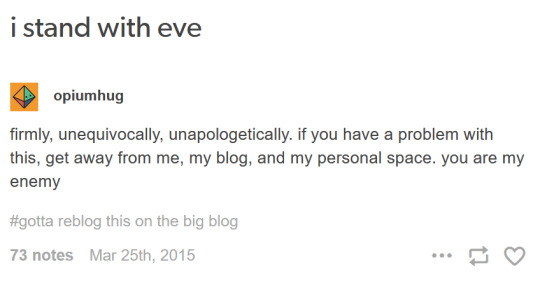
Various reasons were given for this:
The victim must be lying
The victim- and anyone who believed them- was simply transmisogynistic.
Anyone who disagrees with the Baeddels is an Enemy Of The Movement, a “carceral thinker”, and a danger to trans women as a whole.
Trans women are incapable of sexually abusing anyone.
“Standing with Eve” was the ultimate sign of loyalty to the movement, and thus a mark of pride and honor.
It was okay to keep being a Baeddel no matter what, because Rape Accusations Should Be A Personal Matter.
(You can read more about Eve’s own denial of these events here and here.)
Years later, even people involved in the initial group have spoken out against the movement and actions of those involved:
“I was in ~the Baeddels~ for years and like… we straight up did horrible shit.
“We harassed anyone that disagreed for any reason, our politics were terrible, our isolationism made an environmental ripe for abuse that I have firsthand experience of, there is nothing in that group worth salvaging or defending.
“Also acting like people are just bringing this up out of the blue is silly like… it’s being brought up because people are still trying to defend the shit we did instead of fucking recognizing that it was wrong.
“Creating this myth that hate on the Baeddels is just a way of keeping trans women in line is a tacit defense of the horrid shit we did.”
- @lezzyharpy
“like I’m sorry but I served my time in shitty awful Baeddel group in early mid 2012s and it fucking sucked ass.”
“… Like it’s straight up cult-like the way you build this self-reinforcing network wherein ayone on the outside looking in with any criticism is unsafe, not to be trusted, only there to hurt trans women, and the only people you can trust is this self-selected group of trans women.”
- @lezzyharpy
Why It Matters, and Why Baeddelism Never Really Fell
Baeddelism itself has seen multiple attempts at resurgences by various individuals, including documented experiences with self-proclaimed Baeddels as recently as 2018- well after the movement first “fell” in 2014.
Most proponents of “Baeddelism 2.0”, a revival of the original movement, argue that the abuse that occurred within the original movement was either completely fabricated by detractors (sound familiar?) or, at minimum, not actually inherent to the ideology.
And, of course, there are some original Baeddels still active on Tumblr today.
Baeddelism never actually went away.
“Baeddelism” was only one name for a set of beliefs that existed long before the specific term did, and hasn’t gone anywhere since the original Baeddel movement died down.
What the Baeddels did was put a name to the ideology @monetizeyourcat was cultivating before them, and what Cat did was popularize, centralize, and justify a way of thinking that had existed before she ever made her blog.
This ideology has since been referred to, loosely, as “TIRF-ism”: Trans-Inclusive Radical Feminism.
It is rare that anyone actually refers to themselves as a “TIRF”, and there is no real centralized TIRF movement; rather, a loose collection of radical feminist beliefs circulates various transgender spaces. The validity of these beliefs is generally taken for granted: of course (trans) women are The Most Oppressed People; of course (trans) women are Inherently and Unequivocally Victims In All Situations; of course (trans) men are Inherently Oppressors; of course (trans) men are Dangerous and Evil… and so on.
Like Radical Feminism, and subsequently Trans-Exlcusive Radical Feminism (TERF-ism), those ideas are fundamentally dangerous.
The defining tenants of radical feminism are that misogyny is the root of all oppression, and that rather than misogyny being an issue of power and control on a society-wide level, it is instead, or also, a matter of oppression and privilege on an individual level: men are always oppressors, and women are always victims.
These beliefs fundamentally exclude and erase the experiences of other marginalized people.
Namely, people of color and indigenous people, who’s experiences with and concepts of gender do not fall within the strict and rigid lines that white, western, colonialist people’s do.
Radical feminism is not a redeemable ideology. It cannot be reshaped into something good. It is fundamentally broken, and the movements born from it- lesbian separatism, political lesbianism, TERF-ism, TIRF-ism, and Baeddelism- are proof enough of that. They each promote only surface-level variations of what is fundamentally cult-like thinking: only the in-group can be victimized. Only the in-group is safe; the out-group is inherently and universally dangerous. Only the in-group understands you. All members of the in-group are, fundamentally, incapable of abuse.
We cannot allow these ideas to be perpetuated within or without the trans community.
Learn the Signs & Prevent Harm

Here’s what we can do to prevent this from happening again:
Learn what Baeddel ideology and TIRFism look like, even detached from the name.
Learn what radical feminism looks like, even detached from the name. Even from people who claim to oppose radical feminism.
Act on dogwhistles. Call them what they are.
Do not allow people to downplay the harm all forms of Radical Feminism have caused. Remind each other that Radical Feminism is not a redeemable ideology, and seek out other branches of feminism instead.
Remember the harm that has been caused. Remember that it will be caused again if these things are allowed to go unchecked.
Listen to and uplift marginalized people. Allow them to speak to their own experiences, identify their own needs, and name their own oppression.
Remember who the real oppressors are, and do not pit marginalized people against each other. The people perpetuating and benefiting from transphobia are cis people- and more specifically, cis people in power.
Build solidarity with other marginalized people. One group of trans people cannot gain liberation without liberating all trans people, and one group of trans people cannot be targeted without the rest of us suffering as well.
Remember that there is no group or identity incapable of enacting abuse, violence, harassment, or other harm against another. Victimhood should not be determined based solely on an individual’s identity.
Remember that there are no acceptable targets for violence, cruelty, harassment, and abuse.
For more context and a list of red flags, read the rest of the article here:
#baeddelism#baeddel#baeddels#transgender#transunity#transmasc#transandrophobia#transfem#nonbinary#non bianry#transphobia
402 notes
·
View notes
Text
CREATING AUTHENTIC DEAF AND HARD OF HEARING CHARACTERS: A WRITER'S JOURNAL
Introduction
Creating authentic characters in your writing is essential for engaging storytelling, and this includes characters who are deaf or hard of hearing. To craft a character that accurately represents this community, it's crucial to do your research, gain a deep understanding of their experiences, and portray them with sensitivity and respect. In this journal, we'll explore how to write a deaf or hard-of-hearing character, including key information and preparation steps.
Understanding Deaf and Hard-of-Hearing Characters
Research: Start by researching deaf and hard-of-hearing individuals' experiences, challenges, and culture. Read books, articles, and personal stories, and watch documentaries or interviews featuring members of the Deaf community.
Consult with Experts: Reach out to members of the Deaf community or experts in Deaf studies to gain insights into their experiences. They can provide invaluable guidance and help you avoid common misconceptions.
Diversity Within the Community: Understand that the Deaf and hard-of-hearing communities are diverse. Some individuals communicate using sign language, while others rely on lip-reading, cochlear implants, or hearing aids. Be aware of these differences when creating your character.
Character Development
Backstory and Identity: Consider your character's background. Were they born deaf, or did they become deaf later in life? How do they identify within the Deaf community? Understanding their identity and experiences will shape their character.
Language and Communication: Decide how your character communicates. Are they fluent in sign language, or do they primarily rely on lip-reading and spoken language? Their communication style will influence their interactions with other characters.
Cultural Awareness: Explore the cultural aspects of the Deaf community. Understand the importance of Deaf culture, including its history, art, and values. Incorporate these elements into your character's life when relevant.
Writing Tips
Dialogue and Communication: When writing dialogue for a deaf or hard-of-hearing character, be mindful of their unique communication style. Use visual cues, body language, and facial expressions to convey emotions and context.
Access to Information: Consider the challenges your character may face in accessing information. This could involve issues with closed captioning, subtitles, or accommodations in educational or work settings.
Social Interactions: Depict social interactions realistically. Show how your character navigates conversations, group dynamics, and social events within their community and with hearing individuals.
Preparation
Sensitivity Readers: Consider hiring sensitivity readers who are part of the Deaf or hard-of-hearing community to review your work and provide feedback. Their insights can help you avoid stereotypes and inaccuracies.
Learn Sign Language: If your character uses sign language, take the time to learn at least basic signs. This will not only enrich your writing but also demonstrate your commitment to accuracy.
Beta Readers: Seek feedback from a diverse group of beta readers who can assess the authenticity of your character and offer constructive criticism.
Engage with the Community: Attend Deaf community events, workshops, or online forums to immerse yourself in the culture and better understand the perspectives and experiences of deaf and hard-of-hearing individuals.
Creating a deaf or hard-of-hearing character that resonates with readers requires dedication, empathy, and thorough research. By following these steps and embracing the rich culture and diversity of the Deaf community, you can create a character that is not only authentic but also promotes understanding and inclusivity in your writing. In addition, when writing dialogue for your deaf or hard-of-hearing character, remember:
It's important to clarify why, when writing dialogue for a deaf character, you should continue to use structured English grammar and not sign language structured grammar.
Maintaining Structured English Grammar:
Readability: Writing in structured English grammar ensures that the text remains accessible and comprehensible to all readers, including those who may not be familiar with sign language or Deaf culture. It avoids potential confusion that could arise from using sign language grammar in written text.
Universal Understanding: English is a global language, and adhering to its grammar rules allows for a wider audience to understand and engage with your story. Sign language grammar varies between different sign languages, making it less universally applicable in written form.
Respect for the Medium: While sign language is a rich and expressive mode of communication, it is primarily a visual and gestural language. Attempting to replicate sign language grammar in written text can be cumbersome and may not fully capture the nuances of sign language communication.
Balance of Realism and Readability: Striking a balance between authenticity and readability is crucial in storytelling. Maintaining structured English grammar while depicting a deaf character's interactions helps convey the character's experience without compromising the reader's ability to follow the narrative.
As an illustration, consider the following text:
Dialogues with Descriptive Sign Language:
Sarah greeted John with a warm smile, her hands moving gracefully as she signed, "Hi, how are you?"
John returned the greeting in sign language, his expressions mirroring his words. "I'm good, thanks. Did you see the new movie?"
Sarah's eyes lit up as she signed back enthusiastically, "Yes, I loved it!"
In summary, using structured English grammar when writing dialogue for a deaf character is a practical and respectful choice that ensures your writing remains inclusive and accessible to a broad audience while still authentically representing the character's identity and experiences.
Furthermore, it's essential to avoid creating a character who is overly perfect or one-dimensional. In real life, we understand that everyone has imperfections and complexities, regardless of whether they are deaf or hard of hearing. Therefore, it's entirely acceptable to depict your character as a villain with a hearing issue if that aligns with your storytelling goals.
#writing deaf characters#hard of hearing#writing tips#writing resources#sign language#bsl#asl#auslan#fiction writing#building a character#writing guilde#writing characters with disibilities
1K notes
·
View notes
Note
I firmly believe that Lucifer thinks reader (unwanted soul) as either his kid or younger sibling by how he threatened Alastor if he hurts them. Also I find it cute if Lucifer makes reader an unlimited page book since he's worried if they got into a too heated battle they won't notice their pages are thinning. I mean if he can make fantastic rubber ducks with amazing abilities, I'm sure he can somehow make an unlimited notepad for reader to use. Or at least he gives reader a new welcome to the hotel gift, and because he hasn't seen them in a while
Also I wanted to add to the if alastor got into heaven version where he's dead and got redeemed. Reader would isolate themselves so much so that Lucifer visits once a week to check them. And when extermination day hits again (if it happens again), Lucifer would force reader to reside in the hotel for their well-being. That's where they meet Alastor in his all angel-looking feature glory. He probably checked on their old house first, when he didn't find them he definitely raged killed some demons on the way. But he still feels some sort of connection that lead him to the hotel where he finally found reader.
(Can you tell how obsessed I'm with this series)
Go to MASTERLIST for the works. This ask is for {Unwanted Souls}.
Ohh, I wonder if you're making Reader too op.
Part 1: Reader's/your gift from Lucifer
Instead of focusing on the book or notebook, let me direct your attention elsewhere. Ever thought about the quill?
If you know how a feathered quill looks, you'll get what I mean. A quill essentially needs to be dipped in a jar of ink to write. Did I ever mention Reader/you carrying one or even using one? No. Never was 'ink' even mentioned in the story or the trivia (asks). Because that quill was a gift from Lucifer. A quill created by Lucifer and gifted to you. It's enchanted to be writable without ink and on any surface, with a camouflage mode to suit your preference, last feature is that only you can use it.
Why Lucifer gave you a quill is because he knows you don't have to use pages as your surface to do crazy things (summoning weapons and casting spells). You can write on a wall, blow on it and it disappears to do what you wrote. That includes writing on the skin of a demon. If you read the demon design, you'll know what I mean.
The writing on pages part was just a handicap you gave yourself and it was convenient for you to carry around a book or even a small pad to write with. Plus, you don't like attention, so you use a book with limits. You know you'll go overboard when your emotions rule over you, so you limit yourself.
Part 2: Yandere Redeemed Exterminator Leader!Alastor (what a long title for him)
For context, check this ask.
You do isolate yourself to the point it is concerning. Because you don't ask for help and you did when you asked Lucifer if he could provide you with new quarters that was far from where you were or the hotel. So many reminders of Alastor around you, you can't take it.
Seeing you in such despair, Lucifer shared with you that the souls in Heaven were granted the gift of forgetting when they entered the golden gates. You got the idea of forgetting the years spent with Alastor, from the point you saved him to the point you rage-killed for him. Lucifer advised you not to, but you were persistent in your plan. You returned back to the old place, scrolling around to make sure nothing was amiss and took in the final sorrow of nostalgia. Then you wrote down your command on your skin, you watched the words sink in and then everything went black.
Here, you were back to normal, save for Lucifer being the only one (again) who knew what happened to you. Not sure if exterminations continue (since no season 2 yet), but say that it does but further apart as a compromise for Charlie to save more souls. Lucifer visits you, but only to check and see if your memories came back, when they didn't for a long while, he didn't come as often.
When Alastor came down to Hell, he went to your apartment first thing. It was extermination day, so you were definitely there. You were sleeping through the day until your charms alerted you that there was someone in your apartment. You summoned a dagger made of angelic steel, creeping to the living room.
The moment you saw the pair of white wings, you ambushed and knocked Alastor down to the ground. You kneel on top of him to keep him down, the blade at his neck. "I'll give you a chance to leave and your head won't go rolling on my floor. You can fly back to your precious paradise and I'll let you."
Alastor's head turned to face you, a complete 180 without trouble, his smile softened as he praised, "My darling, you're beautiful."
"What?"
"Why would I want to leave you? I've done so much to come back to you. I'll never leave you, dear. If you want, I can give you my wings to make up for my absence."
Your face twisted to confusion and disgust. "What? Who are you?"
Alastor's eyes searched your face, his eyes scanned around, some things and items were missing. His signature red that would be mixed into your apartment. It was all gone. Just as he lost his memory, yours was somehow gone as well. "I'm.. Alastor. Don't you remember me, My Doe?"
#Circe's Nighty Writings#alastor imagine#alastor x reader#alastor x y/n#alastor x you#hazbin hotel#hazbin hotel alastor#alastor headcanons#hazbin hotel fanfiction#alastor#hazbin hotel oneshots#yandere alastor#yandere alastor x reader#yandere hazbin hotel#alastor fanfiction#hazbin hotel imagines#Unwanted Soul
185 notes
·
View notes
Text
alright, here it is: ZENO'S COLOR GUIDE 3.0 !

here, i'll have three "chapters" regarding color:
CH1: how i color in illustrations
CH2: color and character design (in zeno's case)
CH3: how zeno makes his colors cooler
CH1: HOW I COLOR IN ILLUSTRATIONS
it must be noted that, as of lately, i heavily use halftones in my art and the way i use them for gradients effects my color choices. of course you don't need to use halftones if you don't want to, as it's just my personal choice, but anything regarding halftones here could (probably) also apply to regular gradients!
when choosing colors in an illustration, i usually have three things in mind: mood, character, and contrast. we'll be using "gloomy bunny naptime" as an example here.
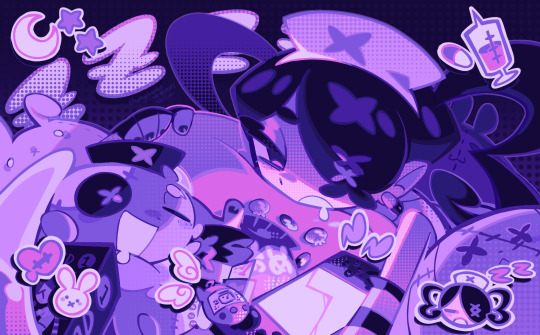
MOOD: what's the vibe of the piece? for example, here in "gloomy bunny naptime", wanted a mellow, sleepy vibe, so purples and pinks seemed like the best choice. these colors also have a dreamy effect due to being common in real-life early mornings/summer nights - basically, i tend to use associative colors in illustrations.
i usually only use a pallete of 3-7 colors, though of course more characters calls for more colors. for multi-character pieces, i would actually make a "rainbow" of colors based on the mood of the piece - essentially, a bank of colors to use for your colorful casts based on the actual rainbow. you can alter this based on the saturation levels you want! hope that makes sense. i'm not the best at this though, so i would heavily recommend looking for guides from artists who are more skilled in that department.
CHARACTER: velvet is the focus of the piece, and as a character her palette is made up of many purples and pinks. of course, it's easier because she and ribbon both have similar designs, but i would still recommend using colors based on/complementary to the focus character's pallete, though this is a rule that can and should be broken if needed. gradients can be used to provide a smooth transition from color-to-color and add depth to the piece, as well as showcase velvet's pallete. when making any gradient, you probably want to have a vibrant middle color. this is difficult to achieve in most art programs, so i'd do it like this:
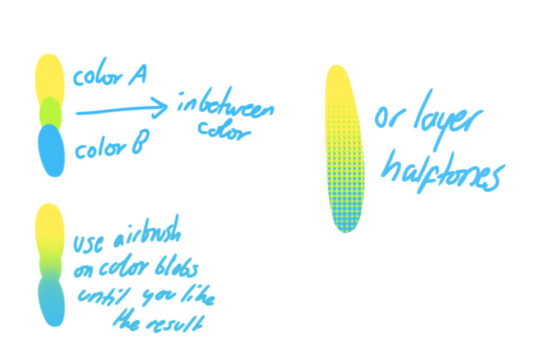
you can use gradients in lots of cool ways to make stuff pop! (i think this collage shows i use too much purple and pink though.)

CONTRAST: the context of the piece also aids the color through contrast. (that's a lot of Cs!)- we see that velvet is just waking up, and the light from her switch is glowing brightly. i wanted to convey something like her switch suddenly turning on in the middle of the night, waking her up - so the console emits "light" in the form of illuminating the contrasting color of pink against the purples. it might seem specific to this piece, but what i'm trying to say is that contrasting colors can lead the eye to the focal point of the piece, that being velvet herself. because a great deal of the rest of the piece is dark, we look at the contrasting switch screen - the brightest thing in frame - and our eyes move around and up to take in the focal point character. at least that's how i wanted it to be ;w; i guess you could convey it as something like this?

CH2: COLOR AND CHARACTER DESIGN (IN ZENO'S CASE)
this is where i start to get annoying, so stand back! when deciding on colors for a cast of characters, there are many factors: time period, variety, personality, and more that i can't think of.
TIME PERIOD: this one is simple. for example, a futuristic time period (such as that in x-calibur) calls for colder colors, such as greens and blues. for characters involved in futuristic professions such as space exploration, this works incredibly well. for modern time periods, less focus can be on colors and more on the shapes of the clothes, but this is not a shapes tutorial! i don't have any ancient times oc stories, but i'd probably use earthy and warm tones.
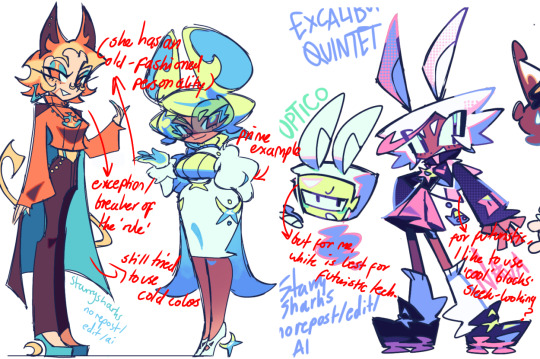
VARIETY: this is also rather simple. i try to be aware of the palletes that i used, and the similarities they might have with other characters. i try to use similar colors for characters who belong to certain organisations or have a uniform, but of course, it's not like catholic school students adhere their entire look to their uniform, so this is a rule that can be broken yet again. art is all about learning things and breaking them, remember that!!!
color can also be used for symbolism. my absolute fav example for this is vivica and octavia - the amount of red in their designs is supposed to represent the amount of freedom/passion/anger/confidence they have or are allowed to express under their different circumstances. as vivica belongs to a strict organisation, she has far less red in her design, showing her emotions are stifled - meanwhile octavia has it as her main complementary color because of her freedom to express her emotions, though those emotions may be destructive because of her circumstances.
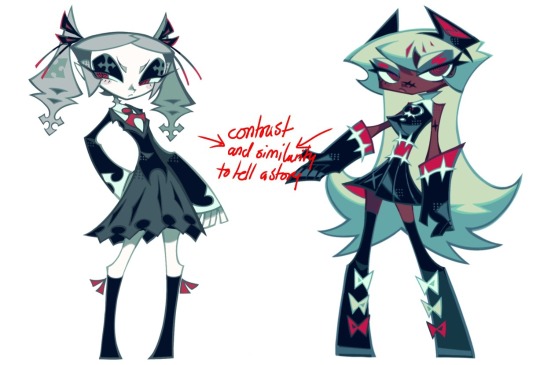
PERSONALITY: what colors are associated with your character's personality? i actually usually refer to magical girl groups to see what's commonly associated with different colors. here's the main trend:
red: hot-headed, passionate, firey
orange/yellow: bright, happy-go-lucky, sunshine personality
green: wise, mellow, kind
blue: serene, graceful, elegant
purple: magical, regal, fancy
pink: usually the main character (though this because magical girl anime tends to be marketed towards young girls), sweet, relatable, determined
of course these are only stereotypes from one genre of anime, and different colors have tons of different meanings. color theory is the best way to learn this! these colors can also express different moods, which ties into ch1. i myself constantly ignore these rules - v-con, a bombastic hyper DJ, is purple (though he does have yellow accents) for example. basically, i just take them as a general rule and try to have them in mind while drawing.
CH3: HOW ZENO MAKES HIS COLORS COOLER
this might be the most important part of this guide. once again, there are a few things to consider here: filters, hue, overlays, and more!
FILTERS: for ibispaint, you can use an adjustment layer on your whole piece to use a filter. i usually only use brightness/contrast here - upping the brightness (or darkening it based on the mood of the piece) and upping the contrast. this helps to better express values and intensify the colors if that's what you want. i often use it in all my pieces to some extent.
hue/saturation/lightness is also helpful in moderation. you can alter the hue - though it usually only helps if you bring it back or forward by just a few points, or the entire pallete will change. saturation is what it sounds like, and slightly over/desaturating the piece can help with atmosphere. lightness is what it sounds like - lightens the colors in the piece. i don't use it at all.
posterize and sharpen mask are some that i've used recently. posterize can add some crazy effects to your art, but i'd probably need to edit it slightly after using it because it can mess with certain colors.

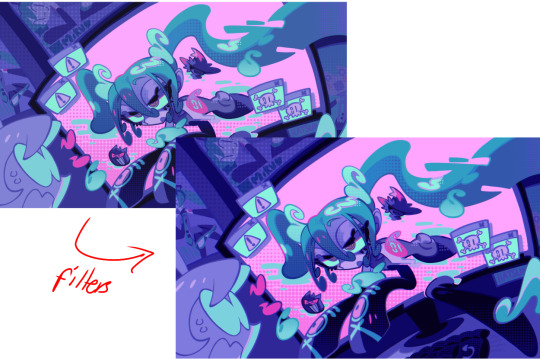
HUE: it's a layer type that can change the overall hue of the piece. i usually use it at a low percentage for atmosphere. kind of like a gradient map but nothing like it? idk
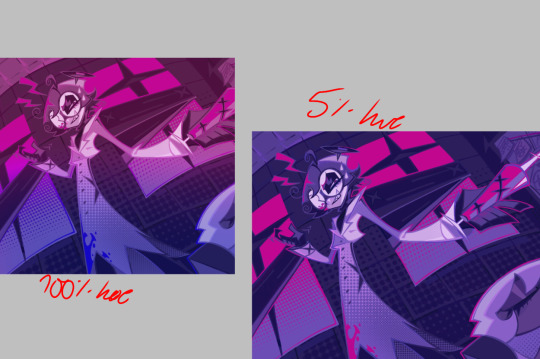
and OVERLAYS: i just use a very saturated blue/purple color over the entire piece at a very low percentage, around 5-10%. it can wash out the piece at too high a percentage.
and that's basically it! sorry it kind of derailed at the end i spent like 2 hours on this and got super tired. goodnight i'm going to sleep please also look at other artists etc etc. bye.
#zeno's art#long post#color tutorial#liar by korn is actually a really catchy song yea the lyrics are weird but its so good tbh#peak drums and bass and guitar and vocals and then the lyrics are hot booty. this is what nu metal's all about people#ask questions if you want#about nu metal or art i dont care
312 notes
·
View notes
Note
hello, can you explain to me in more clarity your “waxen” theory regarding Ianthe? I’m not picking up on what this implies but it’s making my brain itch.
Sort of! Totally fair question, I just don't have a lot of clarity myself in that I don't have a fully formed theory lol. There's definitely some links and parallels in verbiage that are pinging on my radar, so I do think something's funky, but I wouldn't say I'm fully on board with this yet. I'm just playing in the sandbox Tamsyn has provided us, tossing out ideas and thinking out loud. But I can go into some more detail, and add some more thoughts that have occurred to me since I posted that last night.
(Here's a link to the post in question, for context)
Anyway! So let's first lay out all the times we get someone described as some type of wax. At various points in HtN, we get the descriptions "a shoddy wax cast of some more beautiful sculpture," a "wax figure in a pink dolly dress," a "wax figure in pale purple chiffon," and "waxen face" for Ianthe. We also see that descriptor used a few other times for other people throughout the series. In GtN, Harrow's parents' bodies are called "waxy" and the first introduction of Protesilaus (as the beguiling corpse) says he was "waxen looking in the sunlight." In NtN, Kiriona's skin is said to have a "weird, waxy quality," then Naberius's skin is called "waxen" when they first meet up with Ianthe, and again a few pages later it again references the "waxen, handsome face". What I'm getting at here is that every time this sort of description is deployed, it's in reference to a dead body that's been preserved, manipulated, and is essentially masquerading as a living person... except for Ianthe.
We also know there are a multitude of times that she's described as looking like a poor copy of Coronabeth. There's that "shoddy wax cast of some more beautiful sculpture" line, her first introduction calls her a "starved shadow" of her sister ("or the first an illuminated reflection [of Ianthe]," and actually, off the top of my head I don't know that we ever see their descriptions framed that way again... I'd have to investigate this more later, but this might be the only time that Corona is described as a "better" version of Ianthe, rather than Ianthe being a "worse" version of Corona, which is interesting), there's a point where it says "The second twin was as though the first had been taken to pieces and put back together without any genius. She wore a robe of the same cloth and colour, but on her it was a beautiful shroud on a mummy," etc etc etc. I know there's more, but I'm too lazy to go pull the rest of the quotes and you get the picture by this point I'm sure. So nearly all of these situate her, at least visually, as a copy or approximation of Coronabeth, and one that doesn't quite live up to original at that.
So now let's pick apart this snippet of conversation we overhear between Silas and Ianthe at Magnus and Abigail's dinner party a bit. Ianthe says she was born via "surgical means," which I'm assuming is referring to a C-section delivery (or whatever the necromantic equivalent is) and notes that Corona is a few minutes older. Silas seems surprised (or perhaps concerned?) that they "risked intervention" and Ianthe says Corona had "removed [her] source of oxygen". At this point Silas says, "A wasted opportunity, I'd think." I had always taken this for him just being a dick and implying he wished she'd died in the womb, but coming back to it with this new angle... well. She says "Corona's birth put my survivability somewhere around definite nil." And I'm wondering if that doesn't tie to Harrow's comment about infant deaths generating "enough thanergy to take out the entire planet." Basically, could Silas have been implying that the Tridentarii's parents wasted an opportunity to use the thanergy from baby Ianthe's death to power up Corona?
Harrow says that twins are an ill omen, but the text hasn't come back to that as of yet. Given the difficulty necromancers experience with pregnancy, I'd imagine twins would could be especially dangerous and that in and of itself could be considered an ill omen. Ianthe's comments certainly suggest that their mother carried the pregnancy, although I don't think we know for certain whether she was a necromancer. I am so intensely curious about the Tridentarii's childhood and their parents; we get so many gestures towards some really twisted family dynamics, but very little in the way of concrete explanations. Particularly relevant here, I'd love to know more about their father wanting a "matched set" and how that came about. Did they intentionally plan for twins from the start? Was it only once they knew they were having twins that that became a factor? What's the significance there?
Outside of those "waxy" descriptors, Ianthe tends to be described as much more sickly looking than even other necromancers. We know that necromancers on the whole tend towards a phenotype of physical weakness, but even still, there's an emphasis on this with Ianthe beyond that. This might be due in part to narrator bias (coughGideoncough) or the direct juxtaposition between her and Coronabeth's vivaciousness, but what really jumps out at me as contributing to this effect is how frequently she's described as being colorless, pale, washed out, bloodless, pallid, anemic, etc etc etc. It very much makes me think of the way the color drains away from Colum (and even the rest of the room and the others in it) when Silas is siphoning. Silas himself is also often described as colorless ("mayonnaise uncle," "milk man") but not so much in a way that implies frailty as much as I read it as implying a stark coldness, in line with the very black-and-white moral authority he presumes to wield, a purported "purity", much different than Ianthe's colorlessness. With Ianthe, you get a sense that her palette ought to have been or perhaps was closer to Corona's, but the color's been drained away; where Corona's hair is described as golden, Ianthe's is "canned butter", for example. Almost like the life's been siphoned out, one might say.
So to kind of circle back around, do I actually think Ianthe is dead or a corpse like the other "wax" figures we've seen? Nah. Between Harrow and Palamedes, and especially Palamedes's medical necromancy, I think we would have heard about it by now if that were the case. But I do think it's entirely plausible that she's had a bit of a brush with death and that perhaps she's never quite fully come back from, and I do think she's being intentionally positioned as somewhat adjacent to death. If their parents were wanting twins from the outset, perhaps they used necromantic means to encourage the conception. Or if the pregnancy was as high-risk as I suspect it was, perhaps she'd died or nearly died at birth and been resuscitated. Their parents may have gone to extremes to keep her alive, to maintain their matched set. Given the themes of this series, I do feel it's necessary to draw a distinction between "resuscitation" and "resurrection" although they are curiously adjacent to one another. For all the text has grappled with dying and staying dead, dying and coming back, dying and choosing whether or not to return... we haven't touched on what something like a "near death experience" would look like. I'd imagine having that sort of experience, even at an incredibly young age, might lead one to be fascinated with, to use Ianthe's own words, "the place between death and life... the place between release and disappearance."
#it was making my brain itch also!#thank you for indulging my meandering rambles lol#I’ve got another ask sitting in my inbox that I’m working on too… I promise I’m not ignoring it!#tlt#tlt meta#ianthe tridentarius#nona the ninth spoilers#ask#mcdreary#two halves dead
591 notes
·
View notes
Text
Kat watches Moon Knight
Okay, so with the encouragement of several people on here and the emotional support of my roommate, I have finally (in February 2024) started watching Moon Knight, a show whose basic concept scares the shit out of me.
Context: I had an adopted older brother with DID. Note that I said "had". That's past tense because life treated him so appallingly poorly that he died (horribly, in prison) when I was 19. Part of that abuse was enabled by pop-culture depictions of DID in the 1980s and 90s that convinced everyone who knew about his condition (including the court system) that he was a walking time bomb.
One of my earliest memories is of my brother as a young adult, playing Super Mario Bros with my toddler self. Another is of him patiently teaching me how to make friends with a large dog. I never met any of his alters, afaik; I was small and cute and safe for him to be himself with, so he probably didn't need them around me. He was a profoundly gentle man when he was allowed, and it hurt like hell to see him turned into a monster in movies and on TV. I've turned off a lot of "psychological thrillers" in sorrow and disgust.
Ironically, I loved Moon Knight comics as a kid in the 90s, BEFORE he was retconned to have DID circa the mid-2000s. Because those comics came out right after my brother died in 2002 and leaned HARD into making people with DID seem like violently unstable monsters (for reference, see the cover of Moon Knight: God and Country), I stopped reading them around 2008, when I couldn't take being poked in the trauma by a comfort character anymore.
But I do love Werewolf By Night, and there's been a lot of good fic mashing Jack up with Moon Knight without dehumanizing anyone, and several people have encouraged me to try the show. So this post will be a place for my thoughts as I try to work my way through with my Essential Editions in one hand and my memories of my brother in the other. I'll add to it as I watch.
If this entertains the Moon Knight fandom or provides useful fic reference, so be it. Just don't be jerks on my post.
Also, anyone who chooses to be shitty about my brother will be eaten by bears. I don't make the rules.
Episode 1
Okay, we open with Steven as our POV character, and he's...convinced he's a sleepwalker. All right, not terrible. Steven is now a bumbling nerd, which is probably an improvement; good luck making a billionaire playboy sympathetic in the 2020s. Jake would be the logical everyman POV from the comics, but I understand from fic that he's got a different role now. I'm confused about the accent, but it's only episode 1, and Steven clearly doesn't yet know who Khonshu is, or that Marc exists, so obviously there's a ways to go here. (Is Marc ... undercover inside Steven? Ugh, this is a trope I have seen and do not like.)
Did Marc kill Steven's fish? Did Khonshu kill Steven's fish? I'm baffled by the fish. Which is a nice break from the larger anxiety. I'm gonna try to worry more about the fish.
The bits with Steven losing time and finding himself in odd situations were distressingly close to the old tropes, but both of those happened to my brother, so I'm not going to bitch about them quite yet. I want to be as fair as I can.
Oh, hey, I recognize Harrow from the comics. What up, dude. How's the cult biz treating you?
The end of the episode, with the jackal thing chasing Steven into the bathroom, came RIGHT up to the line for me. I realized that what I was most afraid of was that the story would assign "good" and "bad" labels to the alters--make Steven the sweet, innocent one and Marc (or maybe Jake, I guess) the monstrous killer. The early flashes of Steven covered in blood didn't really help allay that anxiety. And now Marc is demanding that Steven let him have control in a pretty threatening manner. But so far, it seems like the contrast between Marc and Steven is one of competence--Marc is better at fighting and Steven is better at ... panicking? Unclear. At least Oscar Isaac is playing the protagonist, so his character(s) might remain sympathetic. Nobody has been monsterized quite yet.
I finished the episode with every muscle in my body locked up, waiting for the emotional punch in the face. But I did finish it, and I think I'm gonna try episode two.
#kat watches moon knight#moon knight#marc spector#steven grant#i guess I'm processing trauma again#hello trauma my old friend
81 notes
·
View notes
Text
So Much (For) Blitz —An exclusive reveal of the star of Fall Out Boy’s latest album cover
Fall Out Boy’s latest effort So Much (For) Stardust) has been critically acclaimed and lauded by fans as some of their best work to date. The album artwork, prominently featuring a doberman, has left some puzzled and looking for additional context as to the dog’s identity and how the artwork came to be. The Bad Habits Collection is proud to bring you the exclusive reveal of the dog featured on the cover of their eighth studio album alongside the full story of how they were discovered.
—
When Fall Out Boy officially announced their eighth studio album on January 18th, 2023 and unveiled the album artwork for So Much (For) Stardust, there were a lot of opinions to be had. Some of the fans immediately felt connected and claimed it as their own, some compared it to Fiona Apple’s 2020 release Fetch the Bolt Cutters, and some downright found it revolting. Overall, most agreed that it was polarizing to say the least. Donned in an all black background, the front cover features both the name of the band and the album itself in the work of Omar Mroz (hereinafter referred to by his online moniker Mr.Oz). The text is covered in glitter and written out in the same style featured earlier in the rollout of FOB8’s album cycle with A Claymation Fall Out Boy Celebration, dropped as a surprise present from the band on Christmas one month earlier. The headlining attraction of this sideshow was in fact just a simple square box, containing a swirling artistic depiction of a doberman barking in the presence of a froth of bubbles.
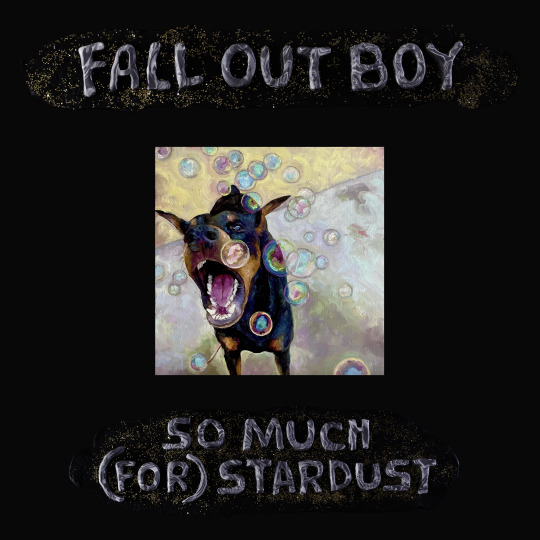
From the moment I first laid eyes on the iconography of Fall Out Boy’s new era, I had just two questions in mind: Who is the dog? & Why choose the dog? A few obvious possibilities were immediately ruled out. Solely based on what’s been posted to social media, this dog did not belong to Pete, Joe, or Andy. Patrick has remained dormant online for years at this point, but still the odds felt slim. I did my best to brush it off, but ultimately I kept coming back to the thought of WHY? If you’re familiar with my previous work on the history of Take This To Your Grave’s album cover, you already know this type of sentiment means a lot to me. After a while of waiting for the band to bring up the topic in an interview or statement, I had essentially given up hope on any type of official explanation. It was at this moment, just 3 days before the release of the record, that I accepted the reality of the situation. This wasn’t a hot topic within the fandom. And no one was going to provide me with the answers I was looking for. If I wanted to know more, it was solely up to me. So… I got to work.
—
To take a step back, the artwork for So Much (For) Stardust first hit the internet on January 11th, seven days before the official reveal. Posted alongside the name of the first single Love From The Other Side, our barking pup friend was featured on the home feed of FILTER | NEWs on VK, a Russian social media site that I’ve been told is comparable to Facebook. The artwork was watermarked with a subtle, transparent white logo for FILTER in the background. Despite this post being up for five days (a millennia on the worldwide web), it wasn’t until the 16th that the fandom at large made this discovery, with many claiming it was an outright fake.
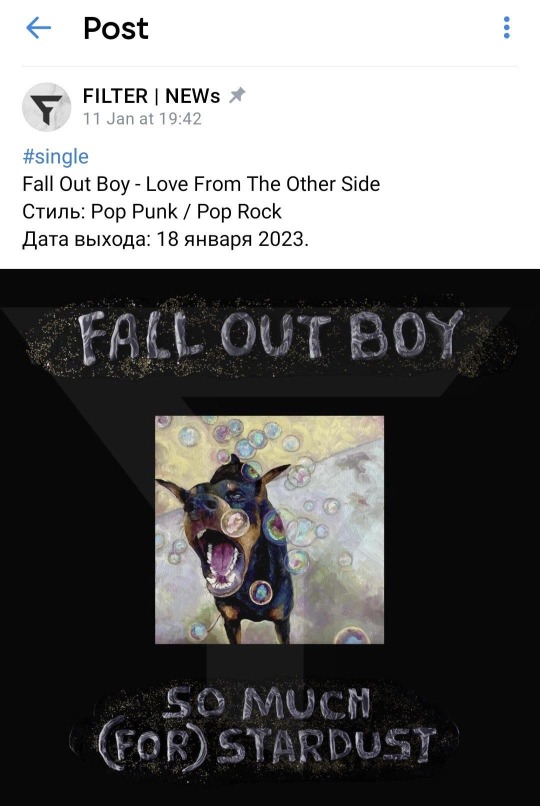
However, the *stars* started to align proving this leak to have a dose or two of authenticity. Mr.Oz’s claymation video from earlier in the rollout followed the story of a similar looking doberman, who just so happened to pose in the final frame in a style strongly resembling the leaked cover.

Beyond that, a post from lyricist and bassist Pete Wentz’s Instagram dating back just two days earlier was quickly dug up. On the 4th slide of the carousel, there it was: a selfie of Pete with a Santa hat on and propped up on the shelf behind him... the physical painting of the doberman seen on the leaked cover.
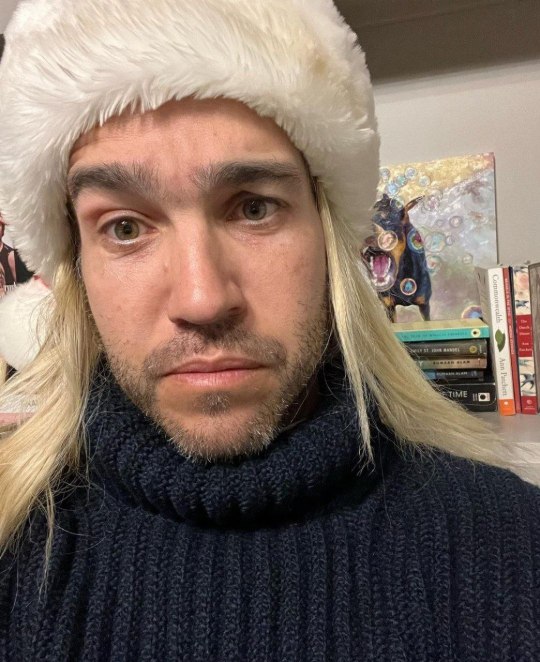
All but confirmed at this point, one last clue presented itself online. The freshly created Twitter account “@muchstardust” popped up out of nowhere, making itself known by following myself and a few other notable hardcore fans in this space. @muchstardust made just one single tweet before being suspended (for reasons unknown).
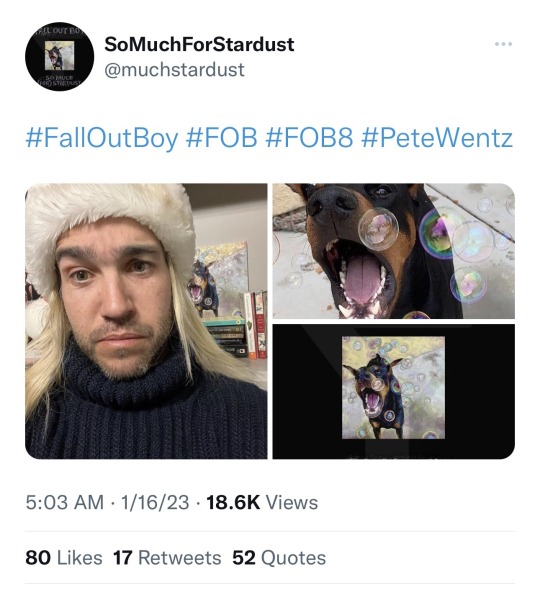
The post featured three images, the watermarked cover, Pete’s selfie, and notably, a compressed form of the actual photo taken of man’s best friend —the same one the leaked cover features an oil painting rendition of.

—
As we all know now, this leak was indeed real and confirmed as the album artwork just a few days later by Fall Out Boy themselves. But that’s when the trail went cold. Later promotional photos featuring the band and taken by their long time collaborator Pamela Littky included another doberman, but clearly not the same one once examined a bit closer. On March 21st, the Chicago rock group posted “What do you think the dog’s name is? 🫧”, but never followed up with the answer. It’s as if they were taunting me specifically with how vocal I had been about wanting to solve this mystery. Just before the album’s official release, I was tipped off by someone with an early copy of the CD that the liner notes of So Much (For) Stardust credit Safia Latif for the cover painting and Jen Patterson for the photograph the cover painting was based on.
With new pieces of the puzzle in play, my search for the dog in question was reignited. However, my leads proved of little to no help. I could not get in touch with Safia and could not properly identify Jen Patterson online for the life of me. Taking the hunt back to the drawing board, I reverse image searched the photo @muchstardust had originally provided, which even at this point, months later, was our only source of the actual photograph. Littered with results of the album artwork naturally, I did come across one potential connection. Once again, I found myself on the public timeline of someone’s VK.com profile. “dextromethorpan 3” had included the same photograph in a gallery of different doberman puppies posted on December 21st, 2020. This was…something. Sure, this photo likely did not originate from the VK profile I had unearthed, but at least now I knew it had been around the web for a few years. Scratching my head, I wondered how Fall Out Boy had originally come across this image. Was it something that came up on one of their feeds? Or perhaps just a keyword search? Taking it to different forms of social media, I found a potential match on the /r/doberman subreddit posted 10 months ago. Titled “Cool pic of us playing with bubbles”, the dobie in question featured strikingly similar features and color patterns, and was of course, playing with bubbles.
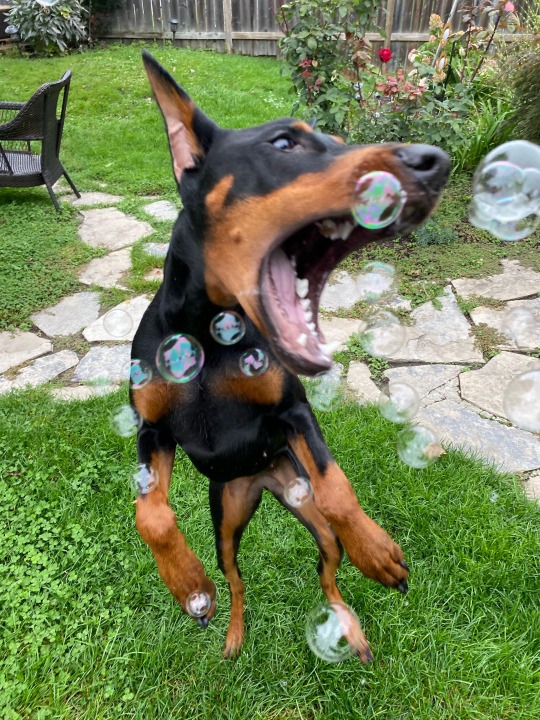
So I did what any other sane fan would do… and sent a private message to the Redditor the night before the album dropped with Jen’s photograph. “/u/drc55555” responded Saturday morning agreeing that the dog did look a lot like their own, but that they didn’t recognize the photograph. I woke up in a cold sweat seeing the glimpse of the Reddit notification on my iPhone and replied informing them of the cover of Fall Out Boy’s brand new release and asking if the user was the Jen Patterson credited in the album’s booklet. A day later, they replied once again noting that they weren’t Jen, but that this has sparked a memory of another DM they had received in the fall of last year from an Elektra Records personnel, Fueled By Ramen’s distributor who Fall Out Boy had publicly rejoined the roster of just this January. Indeed, 200 days ago from this very conversation, a marketing representative from the label had reached out to the Redditor through the same platform letting them know that an artist they work with had come across the very same photo I myself found and that the artist had fallen in love with it, hoping to use it as part of the artwork for an upcoming project. /u/drc55555 had conceded that they regretted not responding at the thought of how their dog could have become famous.
This is when I knew, I was HOT on the trail. Either a member of FOB discovered this photo of their dog while scrolling Reddit or had specifically sought out the same search terms as me, which meant the actual photograph used on the cover could have potentially been found through the very same method. My search accelerated and within a few hours I had run a variety of similar terms by Twitter, TikTok, Facebook, really any social media site I could get my hands on. Nothing had come up, but I hadn’t called it a day quite yet as one of the more obvious sites remained: Instagram. Heading to the explore page I have barely used in my own time on the platform, I typed in the same keywords that brought me to the pup’s uncanny match on Reddit: “doberman bubbles”. And there it was, exactly 60 rows down, right in the center, the original image of the dog I had been looking for all along along with an alternate photo of the same dog in the next slide in the same setting captioned “BUBBLES!!!!!”, posted —you guessed it, in 2020.
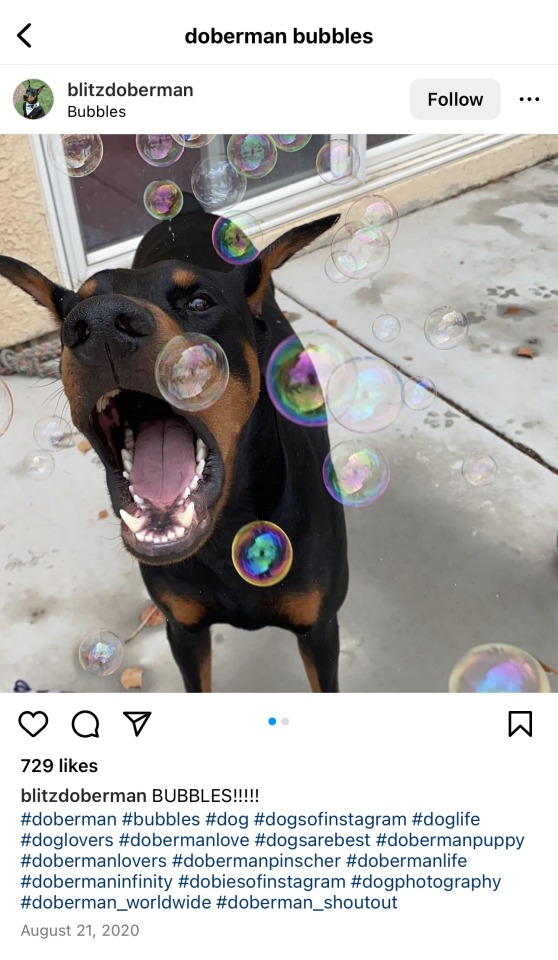
—
With this case officially closed, I’m beyond stoked to introduce Blitz the Doberman to other fans of Fall Out Boy. At the time of publication, Blitz has 12.8k followers on his public Instagram account, which lead me to question how this match hadn’t already been made. Blitz’s bio reveals he was born on February 27th, 2019 and lives in Las Vegas with his human, one Jen Patterson.

In a beautiful twist of fate, within the hour of finishing the final draft of this piece, Blitz’s humans responded to my inquiry from earlier in the week. I spoke with Jen at length who was happy to share her story exclusively with The Bad Habits Collection. Similarly to the Redditor from earlier, a marketing rep from Elektra Records had reached out to her through Instagram on September 20th, 2022 inquiring about using a picture of her pup for one of their artists’ work, a message she initially regarded as spam. Eventually, she came to an agreement with Elektra, however, this story ended there for her. Up until Jen read the direct message I sent to Blitz’s account, she had not the slightest idea that he was featured on the cover of the new album of one of the biggest modern rock bands left in the world. I was shocked to hear this, but Jen on the other hand was incredibly excited to learn of the breaking news. I shared a photo with her of her name printed in the liner notes of So Much (For) Stardust, a cool moment for us both. Jen told me “I never considered myself a photographer, but that’s amazing!” When I asked about how Blitz already had such a huge following on Instagram, she told me all about how she’s networked with others in a doberman group and has kept a steady stream of posts coming on the daily. In discussion of what she’d like for others to take away from this article, Jen simply hoped others would get to know Blitz’s name —my entire goal of this investigation all along. Half-joking, she expressed that she’d also love to have gotten her hands on some merchandise with his face on it. Infinitely grateful for her responding to my DM and taking the time to talk with me, I’ve personally sent Jen physical copies of So Much (For) Stardust in both vinyl and CD format. I’ll be sure to update this write-up with a photo of FOB’s newest mascot posing with his album cover when they arrive!
Closing out our conversation, Jen let me know that she “felt like if you hadn’t reached out, we would not have known.” To be honest, there were times in this journey that I thought it might be for the best if I gave up the search for this pup as to not invade anyone’s privacy. I figured if Blitz hadn’t already made himself known publicly, maybe there was a specific reason behind not doing so. I would have never guessed that reason was because his family were simply unaware of his new-found fame. I feel honored to have been the one to share this discovery with Blitz’s owners and again want to thank them for their contributions to this piece.
Jen has also graciously shared the original photograph of Blitz the cover was based on in its full resolution, uncropped:
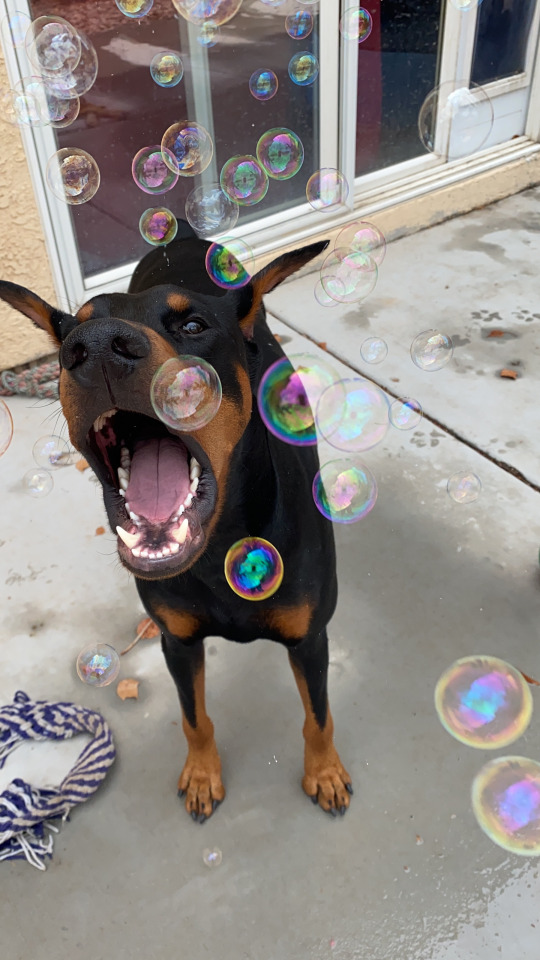
—
After scouring the internet to to uncover this story, it all leads me to just one final question: Why Blitz? What’s the connection? Moreover, what’s the intended meaning here? Jen let me know that she herself was unaware of how and why the photograph was found and selected, but we can naturally draw our own conclusions. Discussing this topic with other longtime fans of the band, all have come to the same conclusion that Fall Out Boy’s latest effort features some of Pete’s bleakest lyrics in a long time paired somehow ever so perfectly with some of Patrick’s most uplifting and dance-worthy melodies to date. As my partner pointed out, the album artwork depicts a breed known for their usage as guard dogs with a tough exterior, but shown playing lightheartedly with what’s usually associated as a child’s toy. In the words of fellow Fall Out Boy historian and Bad Habits Collection collaborator Tommy McPhail, the cover displays “the epitome of boundless joy and simplified bliss amongst chaos”, a phrase that perfectly sums up the entire feeling artistically and masterfully expressed in So Much (For) Stardust in my own eyes.
Fall Out Boy’s newest full-length studio record So Much (For) Stardust, produced by the legendary Neal Avron, is one of their strongest statement pieces in years and is now available everywhere music is streamed or sold.
You can follow Blitz’s adventures on Instagram: @blitzdoberman
—
“The kind of pain you feel to get good in the end. Inscribed like stone and faded by the rain: ‘Give up what you love before it does you in.’”
Written by Alex Toor for The Bad Habits Collection

#Fall Out Boy#FOB#FOB8#So Much (For) Stardust#So Much For Stardust#SMFS#2023#Pete Wentz#Patrick Stump#Joe Trohman#Andy Hurley#Blitz#Blitz Doberman#Blitz The Doberman#Doberman#Fueled By Ramen#Alex Toor#Live On Toor#LiveOnToor
555 notes
·
View notes
Text
Shikigami and onmyōdō through history: truth, fiction and everything in between
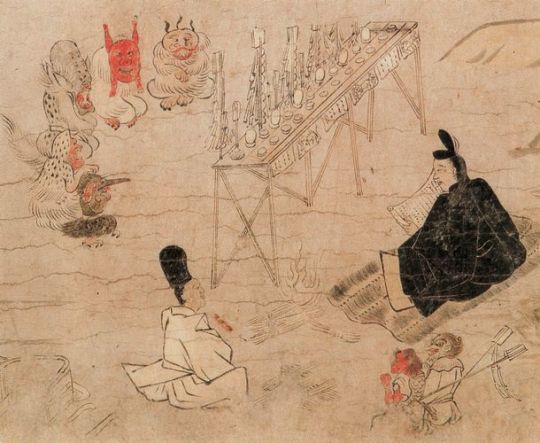
Abe no Seimei exorcising disease spirits (疫病神, yakubyōgami), as depicted in the Fudō Riyaku Engi Emaki. Two creatures who might be shikigami are visible in the bottom right corner (wikimedia commons; identification following Bernard Faure’s Rage and Ravage, pp. 57-58)
In popular culture, shikigami are basically synonymous with onmyōdō. Was this always the case, though? And what is a shikigami, anyway? These questions are surprisingly difficult to answer. I’ve been meaning to attempt to do so for a longer while, but other projects kept getting in the way. Under the cut, you will finally be able to learn all about this matter.
This isn’t just a shikigami article, though. Since historical context is a must, I also provide a brief history of onmyōdō and some of its luminaries. You will also learn if there were female onmyōji, when stars and time periods turn into deities, what onmyōdō has to do with a tale in which Zhong Kui became a king of a certain city in India - and more!
The early days of onmyōdō
In order to at least attempt to explain what the term shikigami might have originally entailed, I first need to briefly summarize the history of onmyōdō (陰陽道). This term can be translated as “way of yin and yang”, and at the core it was a Japanese adaptation of the concepts of, well, yin and yang, as well as the five elements. They reached Japan through Daoist and Buddhist sources. Daoism itself never really became a distinct religion in Japan, but onmyōdō is arguably among the most widespread adaptations of its principles in Japanese context.

Kibi no Makibi, as depicted by Yoshitoshi Tsukioka (wikimedia commons)
It’s not possible to speak of a singular founder of onmyōdō comparable to the patriarchs of Buddhist schools. Bernard Faure notes that in legends the role is sometimes assigned to Kibi no Makibi, an eighth century official who spent around 20 years in China. While he did bring many astronomical treatises with him when he returned, this is ultimately just a legend which developed long after he passed away.
In reality onmyōdō developed gradually starting with the sixth century, when Chinese methods of divination and treatises dealing with these topics first reached Japan. Early on Buddhist monks from the Korean kingdom of Baekje were the main sources of this knowledge. We know for example that the Soga clan employed such a specialist, a certain Gwalleuk (観勒; alternatively known under the Japanese reading of his name, Kanroku).
Obviously, divination was viewed as a very serious affair, so the imperial court aimed to regulate the continental techniques in some way. This was accomplished by emperor Tenmu with the formation of the onmyōryō (陰陽寮), “bureau of yin and yang” as a part of the ritsuryō system of governance. Much like in China, the need to control divination was driven by the fears that otherwise it would be used to legitimize courtly intrigues against the emperor, rebellions and other disturbances.
Officials taught and employed by onmyōryō were referred to as onmyōji (陰陽師). This term can be literally translated as “yin-yang master”. In the Nara period, they were understood essentially as a class of public servants. Their position didn’t substantially differ from that of other specialists from the onmyōryō: calendar makers, officials responsible for proper measurement of time and astrologers. The topics they dealt with evidently weren’t well known among commoners, and they were simply typical members of the literate administrative elite of their times.
Onmyōdō in the Heian period: magic, charisma and nobility
The role of onmyōji changed in the Heian period. They retained the position of official bureaucratic diviners in employ of the court, but they also acquired new duties. The distinction between them and other onmyōryō officials became blurred. Additionally their activity extended to what was collectively referred to as jujutsu (呪術), something like “magic” though this does not fully reflect the nuances of this term. They presided over rainmaking rituals, purification ceremonies, so-called “earth quelling”, and establishing complex networks of temporal and directional taboos.

A Muromachi period depiction of Abe no Seimei (wikimedia commons)
The most famous historical onmyōji like Kamo no Yasunori and his student Abe no Seimei were active at a time when this version of onmyōdō was a fully formed - though obviously still evolving - set of practices and beliefs. In a way they represented a new approach, though - one in which personal charisma seemed to matter just as much, if not more, than official position. This change was recognized as a breakthrough by at least some of their contemporaries. For example, according to the diary of Minamoto no Tsuneyori, the Sakeiki (左經記), “in Japan, the foundations of onmyōdō were laid by Yasunori”.
The changes in part reflected the fact that onmyōji started to be privately contracted for various reasons by aristocrats, in addition to serving the state. Shin’ichi Shigeta notes that it essentially turned them from civil servants into tradespeople. However, he stresses they cannot be considered clergymen: their position was more comparable to that of physicians, and there is no indication they viewed their activities as a distinct religion. Indeed, we know of multiple Heian onmyōji, like Koremune no Fumitaka or Kamo no Ieyoshi, who by their own admission were devout Buddhists who just happened to work as professional diviners.
Shin’ichi Shigeta notes is evidence that in addition to the official, state-sanctioned onmyōji, “unlicensed” onmyōji who acted and dressed like Buddhist clergy, hōshi onmyōji (法師陰陽師) existed. The best known example is Ashiya Dōman, a mainstay of Seimei legends, but others are mentioned in diaries, including the famous Pillow Book. It seems nobles particularly commonly employed them to curse rivals. This was a sphere official onmyōji abstained from due to legal regulations. Curses were effectively considered crimes, and government officials only performed apotropaic rituals meant to protect from them.
The Heian period version of onmyōdō captivated the imagination of writers and artists, and its slightly exaggerated version present in classic literature like Konjaku Monogatari is essentially what modern portrayals in fiction tend to go back to.
Medieval onmyōdō: from abstract concepts to deities

Gozu Tennō (wikimedia commons)
Further important developments occurred between the twelfth and fourteenth centuries. This period was the beginning of the Japanese “middle ages” which lasted all the way up to the establishment of the Tokugawa shogunate. The focus in onmyōdō in part shifted towards new, or at least reinvented, deities, such as calendarical spirits like Daishōgun (大将軍) and Ten’ichijin (天一神), personifications of astral bodies and concepts already crucial in earlier ceremonies. There was also an increased interest in Chinese cosmological figures like Pangu, reimagined in Japan as “king Banko”. However, the most famous example is arguably Gozu Tennō, who you might remember from my Susanoo article.
The changes in medieval onmyōdō can be described as a process of convergence with esoteric Buddhism. The points of connection were rituals focused on astral and underworld deities, such as Taizan Fukun or Shimei (Chinese Siming). Parallels can be drawn between this phenomenon and the intersection between esoteric Buddhism and some Daoist schools in Tang China. Early signs of the development of a direct connection between onmyōdō and Buddhism can already be found in sources from the Heian period, for example Kamo no Yasunori remarked that he and other onmyōji depend on the same sources to gain proper understanding of ceremonies focused on the Big Dipper as Shingon monks do.
Much of the information pertaining to the medieval form of onmyōdō is preserved in Hoki Naiden (ほき内伝; “Inner Tradition of the Square and the Round Offering Vessels”), a text which is part divination manual and part a collection of myths. According to tradition it was compiled by Abe no Seimei, though researchers generally date it to the fourteenth century. For what it’s worth, it does seem likely its author was a descendant of Seimei, though.
Outside of specialized scholarship Hoki Naiden is fairly obscure today, but it’s worth noting that it was a major part of the popular perception of onmyōdō in the Edo period. A novel whose influence is still visible in the modern image of Seimei, Abe no Seimei Monogatari (安部晴明物語), essentially revolves around it, for instance.
Onmyōdō in the Edo period: occupational licensing
Novels aside, the first post-medieval major turning point for the history of onmyōdō was the recognition of the Tsuchimikado family as its official overseers in 1683. They were by no means new to the scene - onmyōji from this family already served the Ashikaga shoguns over 250 years earlier. On top of that, they were descendants of the earlier Abe family, the onmyōji par excellence. The change was not quite the Tsuchimikado’s rise, but rather the fact the government entrusted them with essentially regulating occupational licensing for all onmyōji, even those who in earlier periods existed outside of official administration.
As a result of the new policies, various freelance practitioners could, at least in theory, obtain a permit to perform the duties of an onmyōji. However, as the influence of the Tsuchimikado expanded, they also sought to oblige various specialists who would not be considered onmyōji otherwise to purchase licenses from them. Their aim was to essentially bring all forms of divination under their control. This extended to clergy like Buddhist monks, shugenja and shrine priests on one hand, and to various performers like members of kagura troupes on the other.
Makoto Hayashi points out that while throughout history onmyōji has conventionally been considered a male occupation, it was possible for women to obtain licenses from the Tsuchimikado. Furthermore, there was no distinct term for female onmyōji, in contrast with how female counterparts of Buddhist monks, shrine priests and shugenja were referred to with different terms and had distinct roles defined by their gender.
As far as I know there’s no earlier evidence for female onmyōji, though, so it’s safe to say their emergence had a lot to do with the specifics of the new system. It seems the poems of the daughter of Kamo no Yasunori (her own name is unknown) indicate she was familiar with yin-yang theory or at least more broadly with Chinese philosophy, but that’s a topic for a separate article (stay tuned), and it's not quite the same, obviously.
The Tsuchimikado didn’t aim to create a specific ideology or systems of beliefs. Therefore, individual onmyōji - or, to be more accurate, individual people with onmyōji licenses - in theory could pursue new ideas. This in some cases lead to controversies: for instance, some of the people involved in the (in)famous 1827 Osaka trial of alleged Christians (whether this label really is applicable is a matter of heated debate) were officially licensed onmyōji. Some of them did indeed possess translated books written by Portuguese missionaries, which obviously reflected Catholic outlook. However, Bernard Faure suggests that some of the Edo period onmyōji might have pursued Portuguese sources not strictly because of an interest in Catholicism but simply to obtain another source of astronomical knowledge.
The legacy of onmyōdō
In the Meiji period, onmyōdō was banned alongside shugendō. While the latter tradition experienced a revival in the second half of the twentieth century, the former for the most part didn’t. However, that doesn’t mean the history of onmyōdō ends once and for all in the second half of the nineteenth century.
Even today in some parts of Japan there are local religious traditions which, while not identical with historical onmyōdō, retain a considerable degree of influence from it. An example often cited in scholarship is Izanagi-ryū (いざなぎ流) from the rural Monobe area in the Kōchi Prefecture. Mitsuki Ueno stresses that the occasional references to Izanagi-ryū as “modern onmyōdō” in literature from the 1990s and early 2000s are inaccurate, though. He points out they downplay the unique character of this tradition, and that it shows a variety of influences. Similar arguments have also been made regarding local traditions from the Chūgoku region.
Until relatively recently, in scholarship onmyōdō was basically ignored as superstition unworthy of serious inquiries. This changed in the final decades of the twentieth century, with growing focus on the Japanese middle ages among researchers. The first monographs on onmyōdō were published in the 1980s. While it’s not equally popular as a subject of research as esoteric Buddhism and shugendō, formerly neglected for similar reasons, it has nonetheless managed to become a mainstay of inquiries pertaining to the history of religion in Japan.
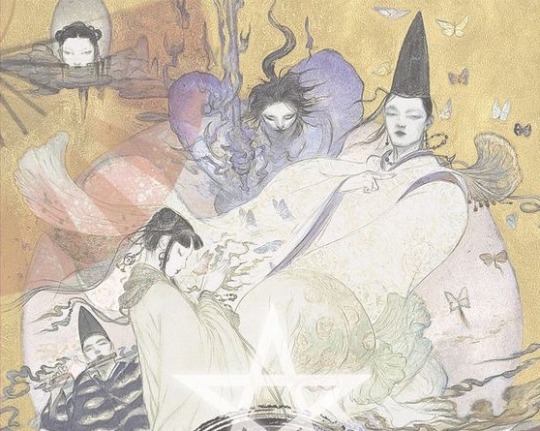
Yoshitaka Amano's illustration of Baku Yumemakura's fictionalized portrayal of Abe no Seimei (right) and other characters from his novels (reproduced here for educational purposes only)
Of course, it’s also impossible to talk about onmyōdō without mentioning the modern “onmyōdō boom”. Starting with the 1980s, onmyōdō once again became a relatively popular topic among writers. Novel series such as Baku Yumemakura’s Onmyōji, Hiroshi Aramata’s Teito Monogatari or Natsuhiko Kyōgoku’s Kyōgōkudō and their adaptations in other media once again popularized it among general audiences. Of course, since these are fantasy or mystery novels, their historical accuracy tends to vary (Yumemakura in particular is reasonably faithful to historical literature, though). Still, they have a lasting impact which would be impossible to accomplish with scholarship alone.
Shikigami: historical truth, historical fiction, or both?
You might have noticed that despite promising a history of shikigami, I haven’t used this term even once through the entire crash course in history of onmyōdō. This was a conscious choice. Shikigami do not appear in any onmyōdō texts, even though they are a mainstay of texts about onmyōdō, and especially of modern literature involving onmyōji.
It would be unfair to say shikigami and their prominence are merely a modern misconception, though. Virtually all of the famous legends about onmyōji feature shikigami, starting with the earliest examples from the eleventh century. Based on Konjaku Monogatari, there evidently was a fascination with shikigami at the time of its compilation. Fujiwara no Akihira in the Shinsarugakuki treats the control of shikigami as an essential skill of an onmyōji, alongside the abilities to “freely summon the twelve guardian deities, call thirty-six types of wild birds (...), create spells and talismans, open and close the eyes of kijin (鬼神; “demon gods”), and manipulate human souls”.
It is generally agreed that such accounts, even though they belong to the realm of literary fiction, can shed light on the nature and importance of shikigami. They ultimately reflect their historical context to some degree. Furthermore, it is not impossible that popular understanding of shikigami based on literary texts influenced genuine onmyōdō tradition. It’s worth pointing out that today legends about Abe no Seimei involving them are disseminated by two contemporary shrines dedicated to him, the Seimei Shrine (晴明神社) in Kyoto and the Abe no Seimei Shrine (安倍晴明神社) in Osaka. Interconnected networks of exchange between literature and religious practice are hardly a unique or modern phenomenon.
However, even with possible evidence from historical literature taken into account, it is not easy to define shikigami. The word itself can be written in three different ways: 式神 (or just 式), 識神 and 職神, with the first being the default option. The descriptions are even more varied, which understandably lead to the rise of numerous interpretations in modern scholarship. Carolyn Pang in her recent treatments of shikigami, which you can find in the bibliography, has recently divided them into five categories. I will follow her classification below.
Shikigami take 1: rikujin-shikisen

An example of shikiban, the divination board used in rikujin-shikisen (Museum of Kyoto, via onmarkproductions.com; reproduced here for educational purposes only)
A common view is that shikigami originate as a symbolic representation of the power of shikisen (式占) or more specifically rikujin-shikisen (六壬式占), the most common form of divination in onmyōdō. It developed from Chinese divination methods in the Nara period, and remained in the vogue all the way up to the sixteenth century, when it was replaced by ekisen (易占), a method derived from the Chinese Book of Changes.
Shikisen required a special divination board known as shikiban (式盤), which consists of a square base, the “earth panel” (地盤, jiban), and a rotating circle placed on top of it, the “heaven panel” (天盤, tenban). The former was marked with twelve points representing the signs of the zodiac and the latter with representations of the “twelve guardians of the months” (十二月将, jūni-gatsushō; their identity is not well defined). The heaven panel had to be rotated, and the diviner had to interpret what the resulting combination of symbols represents. Most commonly, it was treated as an indication whether an unusual phenomenon (怪/恠, ke) had positive or negative implications.
It’s worth pointing out that in the middle ages the shikiban also came to be used in some esoteric Buddhist rituals, chiefly these focused on Dakiniten, Shōten and Nyoirin Kannon. However, they were only performed between the late Heian and Muromachi periods, and relatively little is known about them. In most cases the divination board was most likely modified to reference the appropriate esoteric deities.
Shikigami take 2: cognitive abilities
While the view that shikigami represented shikisen is strengthened by the fact both terms share the kanji 式, a variant writing, 識神, lead to the development of another proposal. Since the basic meaning of 識 is “consciousness”, it is sometimes argued that shikigami were originally an “anthropomorphic realization of the active psychological or mental state”, as Caroline Pang put it - essentially, a representation of the will of an onmyōji. Most of the potential evidence in this case comes from Buddhist texts, such as Bosatsushotaikyō (菩薩処胎経).
However, Bernard Faure assumes that the writing 識神 was a secondary reinterpretation, basically a wordplay based on homonymy. He points out the Buddhist sources treat this writing of shikigami as a synonym of kushōjin (倶生神). This term can be literally translated as “deities born at the same time”. Most commonly it designates a pair of minor deities who, as their name indicates, come into existence when a person is born, and then records their deeds through their entire life. Once the time for Enma’s judgment after death comes, they present him with their compiled records. It has been argued that they essentially function like a personification of conscience.
Shikigami take 3: energy
A further speculative interpretation of shikigami in scholarship is that this term was understood as a type of energy present in objects or living beings which onmyōji were believed to be capable of drawing out and harnessing to their ends. This could be an adaptation of the Daoist notion of qi (氣). If this definition is correct, pieces of paper or wooden instruments used in purification ceremonies might be examples of objects utilized to channel shikigami.
The interpretation of shikigami as a form of energy is possibly reflected in Konjaku Monogatari in the tale The Tutelage of Abe no Seimei under Tadayuki. It revolves around Abe no Seimei’s visit to the house of the Buddhist monk Kuwanten from Hirosawa. Another of his guests asks Seimei if he is capable of killing a person with his powers, and if he possesses shikigami. He affirms that this is possible, but makes it clear that it is not an easy task. Since the guests keep urging him to demonstrate nonetheless, he promptly demonstrates it using a blade of grass. Once it falls on a frog, the animal is instantly crushed to death. From the same tale we learn that Seimei’s control over shikigami also let him remotely close the doors and shutters in his house while nobody was inside.
Shikigami take 4: curse
As I already mentioned, arts which can be broadly described as magic - like the already mentioned jujutsu or juhō (呪法, “magic rituals”) - were regarded as a core part of onmyōji’s repertoire from the Heian period onward. On top of that, the unlicensed onmyōji were almost exclusively associated with curses. Therefore, it probably won’t surprise you to learn that yet another theory suggests shikigami is simply a term for spells, curses or both. A possible example can be found in Konjaku Monogatari, in the tale Seimei sealing the young Archivist Minor Captains curse - the eponymous curse, which Seimei overcomes with protective rituals, is described as a shikigami.

Kunisuda Utagawa's illustration of an actor portraying Dōman in a kabuki play (wikimedia commons)
Similarities between certain descriptions of shikigami and practices such as fuko (巫蠱) and goraihō (五雷法) have been pointed out. Both of these originate in China. Fuko is the use of poisonous, venomous or otherwise negatively perceived animals to create curses, typically by putting them in jars, while goraihō is the Japanese version of Daoist spells meant to control supernatural beings, typically ghosts or foxes. It’s worth noting that a legend according to which Dōman cursed Fujiwara no Michinaga on behalf of lord Horikawa (Fujiwara no Akimitsu) involves him placing the curse - which is itself not described in detail - inside a jar.
Mitsuki Ueno notes that in the Kōchi Prefecture the phrase shiki wo utsu, “to strike with a shiki”, is still used to refer to cursing someone. However, shiki does not necessarily refer to shikigami in this context, but rather to a related but distinct concept - more on that later.
Shikigami take 5: supernatural being
While all four definitions I went through have their proponents, yet another option is by far the most common - the notion of shikigami being supernatural beings controlled by an onmyōji. This is essentially the standard understanding of the term today among general audiences. Sometimes attempts are made to identify it with a specific category of supernatural beings, like spirits (精霊, seirei), kijin or lesser deities (下級神, kakyū shin). However, none of these gained universal support. Generally speaking, there is no strong indication that shikigami were necessarily imagined as individualized beings with distinct traits.
The notion of shikigami being supernatural beings is not just a modern interpretation, though, for the sake of clarity. An early example where the term is unambiguously used this way is a tale from Ōkagami in which Seimei sends a nondescript shikigami to gather information. The entity, who is not described in detail, possesses supernatural skills, but simultaneously still needs to open doors and physically travel.
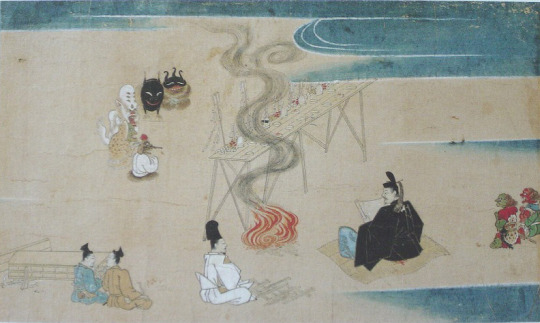
An illustration from Nakifudō Engi Emaki (wikimedia commons)
In Genpei Jōsuiki there is a reference to Seimei’s shikigami having a terrifying appearance which unnerved his wife so much he had to order the entities to hide under a bride instead of residing in his house. Carolyn Pang suggests that this reflects the demon-like depictions from works such as Abe no Seimei-kō Gazō (安倍晴明公画像; you can see it in the Heian section), Fudōriyaku Engi Emaki and Nakifudō Engi Emaki.
Shikigami and related concepts
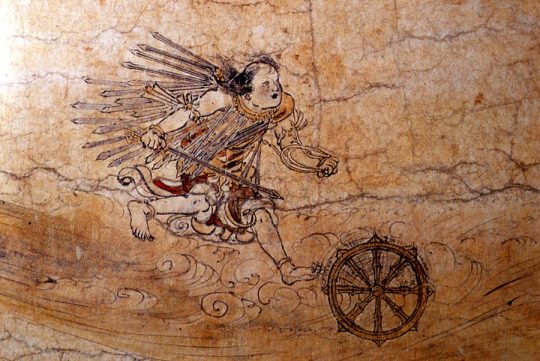
A gohō dōji, as depicted in the Shigisan Engi Emaki (wikimedia commons)
The understanding of shikigami as a “spirit servant” of sorts can be compared with the Buddhist concept of minor protective deities, gohō dōji (護法童子; literally “dharma-protecting lads”). These in turn were just one example of the broad category of gohō (護法), which could be applied to virtually any deity with protective qualities, like the historical Buddha’s defender Vajrapāṇi or the Four Heavenly Kings.
A notable difference between shikigami and gohō is the fact that the former generally required active summoning - through chanting spells and using mudras - while the latter manifested on their own in order to protect the pious. Granted, there are exceptions. There is a well attested legend according to which Abe no Seimei’s shikigami continued to protect his residence on own accord even after he passed away. Shikigami acting on their own are also mentioned in Zoku Kojidan (続古事談). It attributes the political downfall of Minamoto no Takaakira (源高明; 914–98) to his encounter with two shikigami who were left behind after the onmyōji who originally summoned them forgot about them.
A degree of overlap between various classes of supernatural helpers is evident in texts which refer to specific Buddhist figures as shikigami. I already brought up the case of the kushōjin earlier. Another good example is the Tendai monk Kōshū’s (光宗; 1276–1350) description of Oto Gohō (乙護法). He is “a shikigami that follows us like the shadow follows the body. Day or night, he never withdraws; he is the shikigami that protects us” (translation by Bernard Faure). This description is essentially a reversal of the relatively common title “demon who constantly follow beings” (常随魔, jōzuima). It was applied to figures such as Kōjin, Shōten or Matarajin, who were constantly waiting for a chance to obstruct rebirth in a pure land if not placated properly.

The Twelve Heavenly Generals (Tokyo National Museum, via wikimedia commons)
A well attested group of gohō, the Twelve Heavenly Generals (十二神将, jūni shinshō), and especially their leader Konpira (who you might remember from my previous article), could be labeled as shikigami. However, Fujiwara no Akihira’s description of onmyōji skills evidently presents them as two distinct classes of beings.

A kuda-gitsune, as depicted in Shōzan Chomon Kishū by Miyoshi Shōzan (Waseda University History Museum; reproduced here for educational purposes only)
Granted, Akihira also makes it clear that controlling shikigami and animals are two separate skills. Meanwhile, there is evidence that in some cases animal familiars, especially kuda-gitsune used by iizuna (a term referring to shugenja associated with the cult of, nomen omen, Iizuna Gongen, though more broadly also something along the lines of “sorcerer”), were perceived as shikigami.
Beliefs pertaining to gohō dōji and shikigami seemingly merged in Izanagi-ryū, which lead to the rise of the notion of shikiōji (式王子; ōji, literally “prince”, can be another term for gohō dōji). This term refers to supernatural beings summoned by a ritual specialist (祈祷師, kitōshi) using a special formula from doctrinal texts (法文, hōmon). They can fulfill various functions, though most commonly they are invoked to protect a person, to remove supernatural sources of diseases, to counter the influence of another shikiōji or in relation to curses.
Tenkeisei, the god of shikigami
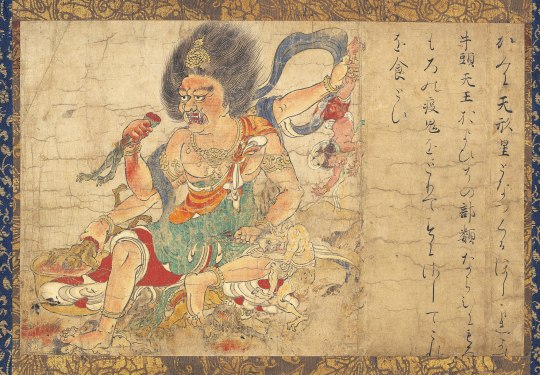
Tenkeisei (wikimedia commons)
The final matter which warrants some discussion is the unusual tradition regarding the origin of shikigami which revolves around a deity associated with this concept.
In the middle ages, a belief that there were exactly eighty four thousand shikigami developed. Their source was the god Tenkeisei (天刑星; also known as Tengyōshō). His name is the Japanese reading of Chinese Tianxingxing. It can be translated as “star of heavenly punishment”. This name fairly accurately explains his character. He was regarded as one of the so-called “baleful stars” (凶星, xiong xing) capable of controlling destiny. The “punishment” his name refers to is his treatment of disease demons (疫鬼, ekiki). However, he could punish humans too if not worshiped properly.
Today Tenkeisei is best known as one of the deities depicted in a series of paintings known as Extermination of Evil, dated to the end of the twelfth century. He has the appearance of a fairly standard multi-armed Buddhist deity. The anonymous painter added a darkly humorous touch by depicting him right as he dips one of the defeated demons in vinegar before eating him. Curiously, his adversaries are said to be Gozu Tennō and his retinue in the accompanying text. This, as you will quickly learn, is a rather unusual portrayal of the relationship between these two deities.
I’m actually not aware of any other depictions of Tenkeisei than the painting you can see above. Katja Triplett notes that onmyōdō rituals associated with him were likely surrounded by an aura of secrecy, and as a result most depictions of him were likely lost or destroyed. At the same time, it seems Tenkeisei enjoyed considerable popularity through the Kamakura period. This is not actually paradoxical when you take the historical context into account: as I outlined in my recent Amaterasu article, certain categories of knowledge were labeled as secret not to make their dissemination forbidden, but to imbue them with more meaning and value.
Numerous talismans inscribed with Tenkeisei’s name are known. Furthermore, manuals of rituals focused on him have been discovered. The best known of them, Tenkeisei-hō (天刑星法; “Tenkeisei rituals”), focuses on an abisha (阿尾捨, from Sanskrit āveśa), a ritual involving possession by the invoked deity. According to a legend was transmitted by Kibi no Makibi and Kamo no Yasunori. The historicity of this claim is doubtful, though: the legend has Kamo no Yasunori visit China, which he never did. Most likely mentioning him and Makibi was just a way to provide the text with additional legitimacy.
Other examples of similar Tenkeisei manuals include Tenkeisei Gyōhō (天刑星行法; “Methods of Tenkeisei Practice”) and Tenkeisei Gyōhō Shidai (天刑星行法次第; “Methods of Procedure for the Tenkeisei Practice”). Copies of these texts have been preserved in the Shingon temple Kōzan-ji.
The Hoki Naiden also mentions Tenkeisei. It equates him with Gozu Tennō, and explains both of these names refer to the same deity, Shōki (商貴), respectively in heaven and on earth. While Shōki is an adaptation of the famous Zhong Kui, it needs to be pointed out that here he is described not as a Tang period physician but as an ancient king of Rajgir in India. Furthermore, he is a yaksha, not a human. This fairly unique reinterpretation is also known from the historical treatise Genkō Shakusho.
Post scriptum
The goal of this article was never to define shikigami. In the light of modern scholarship, it’s basically impossible to provide a single definition in the first place. My aim was different: to illustrate that context is vital when it comes to understanding obscure historical terms. Through history, shikigami evidently meant slightly different things to different people, as reflected in literature. However, this meaning was nonetheless consistently rooted in the evolving perception of onmyōdō - and its internal changes. In other words, it reflected a world which was fundamentally alive.
The popular image of Japanese culture and religion is often that of an artificial, unchanging landscape straight from the “age of the gods”, largely invented in the nineteenth century or later to further less than noble goals. The case of shikigami proves it doesn’t need to be, though. The malleable, ever-changing image of shikigami, which remained a subject of popular speculation for centuries before reemerging in a similar role in modern times, proves that the more complex reality isn’t necessarily any less interesting to new audiences.
Bibliography
Bernard Faure, A Religion in Search of a Founder?
Idem, Rage and Ravage (Gods of Medieval Japan vol. 3)
Makoto Hayashi, The Female Christian Yin-Yang Master
Jun’ichi Koike, Onmyōdō and Folkloric Culture: Three Perspectives for the Development of Research
Irene H. Lin, Child Guardian Spirits (Gohō Dōji) in the Medieval Japanese Imaginaire
Yoshifumi Nishioka, Aspects of Shikiban-Based Mikkyō Rituals
Herman Ooms, Yin-Yang's Changing Clientele, 600-800 (note there is n apparent mistake in one of the footnotes, I'm pretty sure the author wanted to write Mesopotamian astronomy originated 4000 years ago, not 4 millenia BCE as he did; the latter date makes little sense)
Carolyn Pang, Spirit Servant: Narratives of Shikigami and Onmyōdō Developments
Idem, Uncovering Shikigami. The Search for the Spirit Servant of Onmyōdō
Shin’ichi Shigeta, Onmyōdō and the Aristocratic Culture of Everyday Life in Heian Japan
Idem, A Portrait of Abe no Seimei
Katja Triplett, Putting a Face on the Pathogen and Its Nemesis. Images of Tenkeisei and Gozutennō, Epidemic-Related Demons and Gods in Medieval Japan
Mitsuki Umeno, The Origins of the Izanagi-ryū Ritual Techniques: On the Basis of the Izanagi saimon
Katsuaki Yamashita, The Characteristics of On'yōdō and Related Texts
117 notes
·
View notes
Text
How To Build A (Realistic) Femme Fatale Wardrobe: Daily Essentials To Harness Your Dark Feminine Energy
The goal is to feel sexy and sophisticated in well-fitting pieces that are appropriate for the time of day and occasion. Elegance is not embodied by a particular ensemble but by how well-suited it is for the event you're attending. Following proper etiquette involves taking context into account. Femme fatale dressing mixes classic, contemporary, and edgy pieces with a hint of glamour for some extra appeal.
Let's begin with the foundation: Choose pieces that strike a balance between sexy and streamlined. Matching lingerie always makes you feel hot and put together. Make sure its seamless, comfortable, and breathable.
A basic lace bra – in a black or skin-toned colorway (I prefer an underwire with some padding for the look and feel, but adjust for your cup size/comfort if needed).
Pair with a seamless, matching lace thong that can be worn under anything and should not show under your clothes.
For that time of the month, swap out the thong for seamless boyshorts with lace trim (for some much-needed sensuality when you're feeling a bit more sluggish to have some extra coverage).
Shapewear: A high-waisted thong, shorts, or a short bodysuit will likely be the most versatile option (my favorite brands are Commando and Heist). Use to streamline your silhouette (it's not necessarily about size or weight, just making sure your clothes lay properly over your curves).
Simple tops in sensual fabrics (Pima Cotton, Silk, Satin): Every woman needs some well-cut tank tops, t-shirts, and long-sleeve tees. Vary your wardrobe with a few body-conscious and few relaxed styles with each sleeve length. Scoop neck and crew neck options look more refined than v-necks and are more versatile for layering. Turtlenecks are a great option for the colder months and offer sensual appeal without showing any skin. Search for these staple tees in comfortable, luscious fabrics like Pima cotton and washable silk (Everlane has great, more affordable options. Try Lilysilk and Lunya if you want to invest a bit more into these basics).
Camis, Blouses, and Button-Downs: Black silks, satins, leather, coated fabrics, and a simple cotton option or two offer a nice variety for different climates and occasions. Invest in classic button-down options and experiment with wrap-front, turtleneck, halter necks, twist-front, shirred, and strappy details– depending on your personal aesthetic and preferences. Look for luxurious details, like gold or mother of pearl buttons to elevate your daily outfits.
Blazers, Leather Jackets, Trench & Tailored Wool Coats:
Sharp lines and luscious fabrics provide an irresistibly sophisticated allure that allows you to feel sexy and stay warm. Invest at least one of each and ensure they're well-tailored.
(Vegan) Leather, Silk, or Wool Blazer (In Black)
A Classic Moto Jacket
A Black Trench Coat (in cotton or vegan leather) for transitional weather
A Single or Double-Breasted Black Wool Coat (that hits at or right above the knee)
Well-Cut Trousers & A Few Perfect Pairs of Jeans: Go for classic wool trousers, black jeans, or leather pants in a straight or boot-cut silhouette that fits like a glove. Try structured yoga pants or ribbed/leather-trimmed options for lazy days.
Simple Skirts With An Elevated Twist: Try a leather mini skirt or a silk midi skirt to add a more feminine element to your look.
Slip Dress!! Try a black option with or without lace trim – pair it a leather jacket or some type of blazer over the top to keep it casual and classy for daily wear.
Essential Footwear:
Classic Black Loafer (Round or Square-Toe with Minimal Gold or No Hardware)
Black Lace-Up (Combat) Boots
Knee High/Over The Knee Black Boots (Flat Option)
Block Heel Square-Toe Boot (Vagabond has great options for every day – try Miista for slightly more elevated options)
Clean White Sneaker (for super casual days)
Accessories:
Chain-link Necklaces/Bracelets (Gold, Silver, or Mixed Metals)
Simple Hoops/Ear Cuffs
Classic Wrist Watch
A Structured Large Black Tote or Satchel Bag
#femme fatale#femme fetale aesthetic#dark feminine energy#dark femininity#it girl#hypergamous#hypergamy#high value woman#the feminine urge#female manipulator#divine feminine#femcel#fashion#styleinspiration#french girl#girlblogging#gaslight gatekeep girlboss#female excellence#female power#wardrobe#fashion inspiration#coquette#dark coquette#dollete aesthetic#seduction#femmefatalevibe
1K notes
·
View notes
Text
Alastor - Historical Trivia And Headcanons

Alastor was a mixed-race Creole man living in New Orleans, and was in his 30's/40's when he died in 1933. We don't know much else about him, but historical context can provide us with possible additional details:
The population of New Orleans in 1930 was 458,762, more than it is now. 27.2% of the people were black, 3.1% were foreign-born, and roughly half of America's bipoc population was unemployed thanks to the Great Depression. New Orleans' original Francophonication was still strong, and it was common to run into locals who only spoke French dialects (Cajun French, Louisiana Creole). The city has had a huge Chinatown, a small Little Italy, and multiple other districts known for their immigrant African/colonized French cultures.

The Jim Crow laws were heavily enforced, as was the 'One Drop' rule. If Alastor was a mixed race black man, he would not have been able to attend a white school, use the same public transport, and would have shopped at black-local stores and restaurants under threat of violence. If he was mixed with any other race, some Jim Crow laws didn't apply, but state or city laws might specify differently.
Just because Alastor wears a suit, it doesn't mean he was rich in life. Radio personalities often didn't earn a fortune. Unless he owned his own broadcast, he was paid by a private company for long shifts of hosting music, news, and radio plays. In 1930, 40% of households owned at least one radio, which means that a popular radio host would have been easily recognized.
If he was in his late 30's in 1933, he might have fought in WW1, so long as he was over the age of 21. Some cities gave veterans small benefits, or encouraged the community to give them jobs. This often did not include veterans of color.
New Orleans was famous for being one of the least Christian cities in America, thanks to its unique immigrant and slave population. Haitian-based faiths and practices (such as voudo), indigenous cultures, Asian Buddhism, and atheism were common. But Christianity was still the official, law-enforced religion. Schooling involved reading the Bible, laws were sworn to Jesus, etc.

Alastor's outfit in Hazbin Hotel isn't very accurate to real-life American men's fashions of the time. Back then, deviating from the norm with the smallest detail would have stuck out like a sore thumb - like his white-lined lapels. Men always wore a hat. They were allowed to go without a waistcoat, but not a jacket. Belts were becoming more popular than suspenders. The silhouette was bulkier than the slimmer, Italian cuts of our modern times, especially the pants. Hair was kept short, and oiled down in a side part. Americans preferred the clean shaven look. Ties were essential unless you were a blue-collar laborer. Colors were almost universally muted neutral tones for everyday wear. The most colorful textiles for men were sporting outfits, like a tennis jacket.
If Alastor was a middle-class single man, he likely would have lived in an inner-city apartment, in an ethnic neighborhood. He probably didn't own a car, and took public transit like the streetcars. If he owned a house, it would likely have been an inheritance, and even the more opulent houses of the time would have looked small and plain to our eyes.
Because of the Great Depression, unmarried men were becoming the norm, rather than the exception. Men of the community who were sought after but remained single were suspect to gossip, but less ire than you might think; in the '30s, American queer culture was going through a very sharp revival, escaping the rigid Victorian era and before the puritan 40's/50's. But as a mixed-race man, it may have been illegal for a white woman to marry him, as the Jim Crow laws forbade the marriage of white people and Black/Asian people.
A middle class city household would have had electricity, gas heating, indoor plumbing, but may not have had running taps or a gas stove. Even with decent means, Alastor might have been using a potbelly woodburning stove, a dry sink/washbasin, wooden bathtub, and did his own laundry instead of sending it to the neighborhood laundresses. He may or may not have bothered with an icebox. Fresh groceries needed to be cooked and eaten soon, as things like pasteurized milk or store refrigeration wasn't a thing.
If he had enough money, then he almost certainly hired maids or other servants. Whether the maid came over just once a week, or did the shopping and laundry every other day, hired help was much more common back then, especially if he had no wife.
The most popular musicians in 1933 were Bing Crosby, George Olsen, and Leo Reisman. As you might have noticed, it was trendy for the lead singer to be backed by an orchestra, not a 'band' of just four other people like today. The most popular radio shows were Dick Tracy, Sherlock Holmes, and Doc Savage. They were recordings the radio station would buy and then broadcast, or sometimes the actors were live on the air. The radio host was usually not the journalist - the production team was responsible for writing his script.
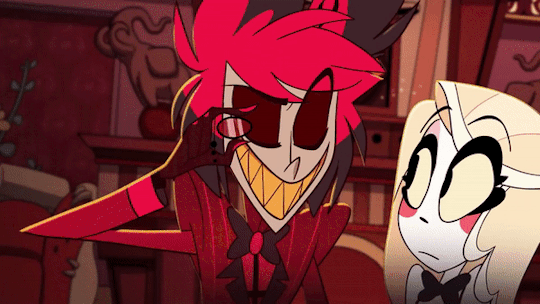
#alastor#alastor the radio demon#hazbin hotel#hazbin alastor#alastor headcanons#hazbin hotel headcanon
103 notes
·
View notes
Text
In this weather I think of this image I saw once and never forgot again: A photo of a man in his 50s on a sunny street in Japan (or at least I recall there were shop signs/advertisements in japanese in the background) wearing a leather jacket with a little fan on the side. Which was amusing enough until someone provided context:
The fan was the only outside-visible part of an air conditioning system he had constructed inside his coat. Summers in Japan are both hot and humid, and the man was - at least by his dress - a part of a local rockabilly-subculture, where the leather jacket is an essential component of a full outfit.
On a scale form one to constructing-a-goddamn-mobile-air-conditioning-system-inside-your-coat, how fucking committed are you to your climate-defying fashion choices.
393 notes
·
View notes
Note
I saw your post regarding the Self-Aware R1999!AU and it was good and mind-blowing! Now I'm wondering how will it go with 6 or 37 regaining consciousness, considering that they're always seeking for the "truth", and maybe the Reader's existence would heighten the quest for the truth more!

;R1999 37 - Self Aware AU

Headcanons about how 37 would act upon becoming self-aware. Related to this Self-Aware AU post.

I RECENTLY FINISHED 6'S ANECDOTE, SO NOW I HAVE A LOT OF THOUGHTS THIS ASK IS A GREAT EXERCISE TO GET THE BRAIN GOING o7
this post only contains 37, since it got a little long and I didn't know how to format it the usual way because I LOVE rambling and rambling. I think there's another ask somewhere about 6 in the self-aware AU, so I'll get to that one soon!
also I think this post is impossible to read if you haven't read chapter 5 at least, bc I use a lot of the terms used in Apeiron!

37 is such an interesting character. Okay okay, bear with me for a bit while I get all of my 37 thoughts out of my brain!
I feel like people downplay how cruel or detached she can be. Because of her innate ability to see numbers in everyone and everything, essentially seeing "the truth" and being able to provide Proof to support her claims, 37 lives disconnected from her entire community while also being upheld as a genius and beacon of progress. She's the "Star of Hermes," after all.
A lot of her character focuses on this alienation and "othering," how her mindset and beliefs set her apart from others as she cannot understand the importance of soul numbers from an emotional standpoint--like she says in the main story, she's always known she's 37. Everyone's known this. And she does not understand the importance of knowing WHY she's 37. She doesn't care about the traits assigned to each number, that is meaningless rhetoric to her, what matters is the final result. She's 37, and that's it. She upholds the purity of numbers, practically worships this pure aspect of the world of Forms. She's at her happiest when she talks about how numbers will always be numbers, no matter who tries to figure them out, or when or how.
And we also see the cruel aspect of her that I believe people overlook--37 admits that she enjoys revealing people's numbers because she wants to be the first to prove this truth. It's only near the end of Chapter 05 that she wonders, if only briefly, whether being the first to prove someone's number means that she knew the truth better. Other than that, she has absolutely NO trouble revealing Vertin's number, nor attempting to tell Sophia her own number as kids--and 37, while she does not care for the rhetoric of numbers and their assigned virtues, knows how much the journey of self-discovery means to her entire community. And she still chose to do this, because she does not see the value in the process.
This isn't to say that she's exclusively a cruel character nor a misguided little baby, I would say that she's cruel the same way a child can be--37 is a very lovely and complex character! I just think people take her cute appearance at face value and forget the extent of her abilities and her perception of the world.
In the context of a Self-Aware AU, I believe that this self-awareness would be recontextualized as yet another eternal truth for her. Her curiosity wouldn't be applied to this, because there is nothing to figure out--the world has always been a game, that's it. Instead of focusing on the emotional or existential aspects, 37 would focus instead on the "guidelines" that rule this fake world.
It would revolve around the mechanical aspects: she understands that every fight follows a set pattern, as this is a turn based combat game. She wants to know why some people stand out, why they're assigned as 6 or 5 or 4 or 3 or 2 stars. Why not a 1 star? Why not 10? Why this system in particular? Why doesn't Sophia have any stars? Is it because she hasn't figured out her number yet? No, that can't be, because 210 also lacks stars. And so on and so forth.
The focus will still be numbers, so she would be the perfect assistant for Players who care a lot about meta!
I'm also willing to say that 37 would be one of the very few characters who has no trouble at all coping with the fact that she's a character in a videogame. To know that she's a bunch of "code" wouldn't change a thing for her, because she was already 37 in the first place!
There is also the aspect of finding out that her mother's death (as well as Sophia's father) was scripted. I'm going on a long tangent here, so bear with me for a second.
I feel like... 37 would see that as a positive thing? First of all, we know that the death of everyone in that boat was caused because of a miscalculation from Sophia and 37's part, which is the catalyst for 37's Emanation research. I do believe that, even though 37 shows little to no (conventional) emotion in that specific moment, she still grieves and mourns in her own way--and the way she does that is by clinging onto the one thing that is left of her mother: her pneuma analysis and research, the computer that stopped working, the pattern of the "Storm". We are told that 37 became a recluse, isolating herself even more from her community, when her and her mother's research was proven to be wrong, that she only came out of her lab when Vertin and her team arrived. We see her muttering while unconscious in the cave with Vertin, calling out for her own mother and telling her that their research wasn't wrong, that they were right all along (because they were missing one vital piece of information that only an outsider like Vertin could deliver).
Second of all, we know that 37 does not understand nor care about fate, she does not care for wordplay that muddies the true essence of numbers. So she would not think that the death of all those people can be attributed to something as vague and nonsensical as "fate."
Third and final point of this tangent, 37 does not like to be proven wrong. Or rather, 6's character event shows us that, no matter what she's told or how she behaves, 37 will always believe that she's in the right.
With all of this in mind, I think that finding out that this accident was something scripted--that is to say, part of the "truth" (or canon, from our perspective) of this world--would reinforce 37's beliefs. This miscalculation was a mistake born from her former self, the 37 that did not truly understand the world, before she achieved self-awareness. And now that she's wide awake, there's no way that she could ever make a mistake like that ever again. If else, I can see her being mildly irritated that it took her this long to open her eyes, struggling with the fact that she's not the first person to become self-aware. And just like she casually reveals other people's numbers, she would dangle the knowledge of self-awareness in front of others instead of keeping it secret.
On the subject of finding out about the Player, I'm not quite sure how 37 would react. Sure, 37's life is ruled by the same dogma that rules everyone else within Apeiron, but her approach is devoid of that same spiritual and religious devotion that others like 210 carry. Like we see in 6's character event, 37 does not care about the importance of the number 6 nor whoever holds the title, because the "truth" is that everyone within that bloodline is going to inherit the title at some point or another. Compare this to 210, who treats the previous 6 (Atticus' aunt, Alma) with such reverence.
So perhaps that's how 37 would act, then? This "divine" figure is yet another 6 for her, someone who has all relevant knowledge, nothing more and nothing less.
I like to think that 37 is able to see the Player very clearly right away, the same way she can see people's numbers, whereas 6 is the one who can hear them clearly, the same way he inherits the Revelation from his ancestors.
And unless you're another super math genius like her, I can absolutely see 37 pouting about it. How come someone like you gets to be "outside" in the world of Forms? Maybe she becomes curious about finding "proof" of your world, to confirm whether you live in the world of Forms or something else entirely, perhaps yet another world of Matters, full of Fragments. Realizing that the world the Player lives in is practically identical to her own--minus the existence of integers and fractions, just a world full of imaginary numbers--would be a curious experience for 37.
I can also see 37 telling Vertin the Player's own soul number the moment she figures it out, perhaps as a way to repay the favour for the events of Chapter 05. Assuming she survives that bomb, I actually don't know what happens in Chapter 06 LMFAO....
Long story short, not many would realize that 37 has become self-aware, since her behaviour remains largely the same. And it wouldn't affect her as deeply as it affects other characters.
31 notes
·
View notes
Text

Well, if you all insist. Here's a cute section for those skk shippers.
Necessary context: this is about a year or so after Vanitas came to Yokohama, so his memories have since returned. Certain other characters from VNC have since made an appearance and some caused issues that won't be spoiled here, but just for the context Naenia *has* hurt Chuuya and made a small impact on his appearance, while also harming him mentally and physically. So this is Dazai trying to comfort Chuuya:
"A puppy?" Vanitas tilted his head, surprised at those words coming from Dazai's mouth- it had been a quiet day at the Agency, so Dazai had asked to borrow Vanitas for what he'd called *personal reasons*. It turned out that Dazai wanted to show his love to Chuuya in a new way, and wanted him to feel better after the last incident they had.
"I'm terrified of dogs, but Chuuya loves them. I want him to be happy, and he put up with so much of my crap." Dazai chuckled, though he was visibly shaking and had grown deathly pale, "I thought maybe I wouldn't be as scared if we got a puppy and raised it so it wouldn't be a vicious monster like the dogs I know."
Vanitas understood that, being afraid of something and worried that it would affect his life if he didn’t get over it. Also he was more of a cat person, so were most of the Agency, as proven by how everyone liked Atsushi. Obviously it wasn't the only reason, but it was a big factor. Humming to himself, Vanitas asked, "Are you wanting to go to the pet store, or..?"
That had been something else Dazai had to think about. He slowly shook his head, "I want to adopt from a shelter. Chuuya would love that, plus even I think it's a good idea, rescuing rather than relying on a possibly sketchy breeder."
Now, Vanitas had come to respect Dazai: he was capable of being cruel and calculating, but he had a heart filled with warmth and kindness, and that wasn't something that anyone could or would ignore. Even when it came to something he hated, Dazai chose the option that was best morally and logically. Yokohama had a lot of strays, so rescue centres were an essential, thus it wasn't difficult to find one. Dazai was terrified, both of the dogs and the thought of this new commitment, but...
Naenia had nearly taken Chuuya from him. He couldn't lose him, not Chuuya. So now, he needed to make sure that he never lost him again, without being manipulative or controlling. Not that anything could truly control Chuuya, he was far too *Human*. Dazai had already fucked up so many times, and it was too much- Chuuya had been the one affected, it was time to fix what he could and ease any pain.
Time froze when a giant grey dog started snarling and barking when Dazai got a little too close to its cage, and he immediately fell on his ass, trying to scoot away while hyperventilating; this was far more than just a fear, this was straight up trauma.
*****
"Stand up and fight, Shūji!!"
Shūji Tsushima was about five years old at this point, standing in a makeshift boxing ring with a metal chain fence circling the entire thing. He and his father were the only people there, but in the cage with him were three dogs at least double Shūji's size. His father was training him to become stronger, he'd said. Shūji wasn't unarmed, he'd been provided a knife, and a gun.
But those snarling fangs had absolutely terrified him, he couldn't even attempt to turn his back and grab the weapons he'd dropped the moment the mutts came out. One had jumped towards him and bit his arm, causing the poor boy to scream and cry, "Father, please help me!!" This wasn't how he wanted to die.
"Pathetic excuse for a son." His father's words was the last voice he heard before he passed out, but the last sounds he heard? Three gunshots.
*****
"Dazai! You're okay, just hold onto me."
That was Vanitas' voice... but wasn't he..?
No. That's right. Shūji Tsushima wasn't here anymore, Osamu Dazai stood in his place, but still had all those same fears, memories and visions. Vanitas was rubbing Dazai's back, slowly guiding him from his panic attack. He did hear the sound of a dog, but no vicious barking, just a whine. Dazai steeled his nerves and looked over at the dog who'd barked, and... it was the one whining. Actually, it looked really sad, like it knew it did something bad.
After taking some calming breaths, Dazai sat up properly and Vanitas reached into his pocket, "I've got chocolate on me, that should help you." The Agency Members always carried some form of snack on them in case Ranpo asked them to tag along, and Vanitas usually carried chocolate, claiming that it was medically beneficial, whatever that meant. However, since Dazai felt better after having a piece, he wasn't inclined to call bullshit.
"...that dog looks sad." It was weak and childish sounding, but Dazai wanted to make sure he was still sort of functioning. Plus, he found himself a little curious.
Vanitas gave him that explanation: that dog was female and had been used for breeding most of her life. She was seven years old, and had only just been rescued, though not before her abusers got one last use out of her. Apparently the name she was given was Viola, and she was expecting another litter of puppies within the next few weeks. It sounded like the sort of sob story that would pull at Sigma's heartstrings.
Once he'd calmed down properly, Dazai decided that after coming this far, he wasn't about to give up now. Vanitas stayed close to him, as they looked around. Animals are more intelligent than some people would make them out to be, and not a single dog barked after Dazai's panic attack. It helped him feel a lot more at ease, and he was able to look at the dogs without breaking out in goosebumps.
Eventually, one large cage caught his attention: the inside was full of puppies that had a mix of tan, white and blueish coloured fur. The mother wasn't with them, and the puppies were clearly a few months old, so they weren't dependent on milk but still very small. Most of them were playing with toys or playfully fighting each other, but there was one who was just... in the corner on its own. It must have been the runt.
Dazai didn't know why, but he found himself kneeling down and while he flinched when he got that runt's attention, he also felt warm inside. Its eyes, one was blue and one was brown, just like Chuuya's! Even in the same positions. The white colour that separated the blue from the tan looked peculiar, it was almost like the shape of lightning bolts, all across its fur. The puppy's ears were tall, far too big for its body, and when it tilted its head at Dazai, its entire body tilted with it, until it fell on its side with a squeak.
"Easy there," Dazai chuckled, carefully reaching out to the cage, letting the puppy catch his scent. The puppy nuzzled his fingers and gave a small lick. Dazai's eyes widened and his thoughts stuttered, *Wait, is this how most people react with dogs? That was so adorable, and I don't think I can leave here without this one.*
"Oh, he never usually goes to people!" The woman who ran the shelter had walked up, having heard about the man fainting in her workplace, "He usually hides in the back away from people. Would you like me to get him out for you?"
Of course Dazai said yes. He was still afraid of dogs, and it would take him forever to recover, but this puppy brought out a reaction that wasn't true terror. She scooped up the puppy and put him on the floor- he scampered up to Dazai, sniffing around him and flopping onto the floor when his ears turned against him again. Dazai smirked again, before stroking his fur, absolutely amazed by how soft it was, he imagined that this was what a cloud would feel like if he could touch them. The puppy yawned and curled up close to him, which sold Dazai completely. After all, if this dog liked Dazai, he would love Chuuya.
However, he looked over at Viola's cage and frowned- all alone in the world and pregnant. Didn't seem fair. Fyodor, Nikolai and Sigma had apparently been talking about getting pets, and while they weren't all on speaking terms, Dazai did keep in touch with Sigma and dialled his number.
*Ring... Ring... click.*
"Dazai? Is everything okay?" Of course Sigma would immediately worry. After giving a brief synopsis of the situation, and the detailed version of Viola's story, Dazai grinned when he heard Sigma's voice become laced with emotion and tears, "Luckily I'm in town. And we did think about getting dogs, so one and some puppies on the way? I think that's that. I'll be right there!"
Dazai laughed when Sigma hung up, likely sprinting here. He told Vanitas, who laughed as well and gave the puppy who claimed Dazai a little stroke, "He's adorable. This one is yours and Chuuya's dog?"
After looking down, and seeing the puppy give him a tail wag, Dazai nodded. This was their dog.
***
"I cannot believe you actually did that." Sigma was walking a cheerful Viola down the street with Dazai, who held a box containing the new pup. He also bought another surprise, but he kept that in his coat pocket.
"Which part? Getting that slug and I a pet, or calling you about someone who clearly needs you?" He teased, but when Sigma had arrived and saw Viola, it was love at first sight. Naturally, Sigma had sent photos to his boyfriends, who practically begged/demanded that he come home with the pregnant dog.
"That you faced your fear so well. And that little one is going to be much happier with you." That made Dazai smile, and he appreciated that thought. "...you are prepared, right? For a dog?"
"Huh? Oh, yeah. I always plan ahead, I actually bought a bunch of dog stuff and hid them on the top of the shelves and my closet so that the shortie couldn't see them." Ah, how long had it been since he'd had a dig at Chuuya's height? It wasn't a lie, though. Dazai had gotten everything necessary and hid it all from Chuuya so that he wouldn't suspect a thing.
After thanking Vanitas and congratulating Sigma on the new family member, and future family members, he headed back to the apartment. Chuuya should be home by now, so he was thankful that the dog had fallen asleep. It wouldn't be much of a surprise if the gift started barking, would it?
Once he opened the door, he heard Chuuya's voice- he was obviously on the phone, and he sounded anxious, maybe a little annoyed? "...so there's no mistakes? Fuck. No- yes, I'm fine. Just... you're definitely sure? This isn't something that you can-... okay, fine." Chuuya took a breath then cleared his throat, "...thanks, *Doc Glasses*. Bye- *yes* I said thanks, fuck off." He hung up the phone, then saw Dazai and lit up with a smile.
Dazai seemed surprised. Ango and Chuuya definitely didn't like each other to say the least, so for them to have an actual discussion with minimal cursing seemed off. But that didn't matter at that moment in time, as Dazai put the box down and went to hug his partner.
Chuuya was still drained and exhausted after Naenia attacked him, the new white streak in his hair showing and nothing could hide it. Dazai just thought it made him look even more beautiful, which he didn't even realise was possible. After a kiss, they sat on the couch, and Dazai made it clear that Chuuya's business was his own, but Chuuya just scoffed a little, "It's... to do with Verlaine."
Oh. No wonder Chuuya had been pacing. They weren't stupid, they knew Verlaine had been alive all these years, and was their superior at one point. Dazai held his hand and squeezed gently, "Wanna talk about it?"
"Not yet, but I will, I promise." Most members of the Port Mafia kept their promises, but the only two who truly kept them were Chuuya and Akutagawa. Sort of.
"Well, no rush. Anyway, I wanted to make you feel better, so I got you something." Dazai pulled out the small box from his coat and handed it over, an idiotic smile on his face.
"What have you done this time?" Chuuya would always be suspicious of any gift that Dazai brought him, since his presents used to be ridiculous in the past: toy slugs, a book about how to train dogs to be obedient, even a rubber knife to replace a real one he once stole then lost on a mission.
Dazai smirked, "Nothing~! It's just a gift to show my appreciation!" When Chuuya went to open it, Dazai quickly cleared his throat, "Ah, but you can't be mad at me."
Chuuya looked at Dazai with furrowed eyebrows, then at the seemingly inconspicuous box tied with a crimson ribbon, "There's not a bomb in here, is there? ...or a stink bug?"
Dazai shook his head, "No, just open it!" When Chuuya finally did, he tried to hide a smirk behind a glare, "What? It's perfect for my loyal dog!"
Inside was a pure black collar, with a tag in the shape of a bone. It didn't have anything engraved on it yet, but that wasn't really what Chuuya focused on, as he half-jokingly called Dazai every name under the sun. "Seriously, Osamu?! A collar?!"
Once he had his fun, Dazai turned serious. He couldn't hold it off any longer, after all. "Chuuya. I do have another gift for you, but I need you to trust me and close your eyes." He blushed when Chuuya *immediately* closed his eyes.
As if to carry on the joke, Dazai had slipped his finger through Chuuya's choker, tugging it slightly in order to pull Chuuya forward for a kiss. He acted as if he was going to completely remove the choker, only to leave it where it belonged and pulled away.
Taking another breath to steady himself, Dazai went to the box and opened it, seeing that the puppy had just started to wake up. His tail wagged at seeing Dazai, who scooped him up, and carried him over.
Swallowing his nerves, he weakly cleared his throat, "O-okay, you can open your eyes now!" Chuuya did, and he froze. Dazai was holding out the tiniest, most fluffy puppy out to him, "Surprise!"
The puppy let out a tiny yap, his tail wagging uncontrollably, and after seeing Dazai give him a look of *please for the love of God, take this puppy out of my hands*, he did, holding him close and letting him sniff, lick and nuzzle him. Dazai had looked really uncomfortable, though it was because he was scared that one wrong move could lead to him getting bitten or something, and yet Dazai was undeniably happy as well, his smile incredibly bright.
He started to cry, he couldn't help it. This was something he'd dreamed about since he learned about dogs, having a puppy of his own. "Is he ours?" He managed to say through his sobbing, which intensified as Dazai nodded. He nuzzled the puppy, who snuggled into him properly, yawning again. "Oh, 'samu. This is the best."
"I wanted to do better with my fear..." He sat with Chuuya and explained everything: the panic attack caused by a frightened Viola, how he was comforted by Vanitas and this puppy, and how they've both now got their forever homes. Chuuya leaned into him and kissed his cheek, making him smile warmly, "Glad to see Chibi thinks I made the right call."
"You really did." Chuuya stayed on the couch, and Dazai retrieved all of the dog supplies he'd hidden- food, toys, a bed, puppy mats, even some medicine in case he ever got sick. Dazai was prepared, and he wasn't letting his fear blind him to the fact that this was a living creature they were taking care of.
They let him roam and explore the apartment, watching him try to climb and run around like a maniac. Chuuya was silently thankful that the puppy didn't have the zoomies, otherwise Dazai would probably faint again. Now there was one last thing to discuss.
The one thing that the shelter didn't do was name the puppies, which naturally meant that the responsibility fell on Double Black. They both took note of the patterns on the puppies fur. Lightening bolts.
Bolt? Cute, but it didn't suit him. Thor? Too generic. Lightening? A bit too long. Zeus? ...actually.
"Zeus is a good name. He's got the lightening patterns, and he's got personality." Dazai couldn't argue with Chuuya's logic, especially since he looked at the puppy and found himself thinking that he *looked* like a Zeus, if that made any sense.
So that was the name they trained him to respond to. And Zeus was welcomed into their home, as a part of their little family. This was how far Chuuya and Dazai's relationship had come, and they loved it, just as much as they both grew to love their little Zeus.
*****
AN: *Psst.* This is what Chuuya looks like from this point, drawn by my cousin, HisDarkDisgrace on AO3:

#bungou stray dogs#the case study of vanitas#vanitas no carte#bsd#bungo stray dogs#vnc#chuuya nakahara#dazai osamu#vnc vanitas#bsd sigma#a guide to tainted sorrow#soukoku#skk#bsd skk#bungo gay dogs
30 notes
·
View notes
Note
What do you think Salems goal is, exactly? It's obviously not ending the world to kill herself, but honestly I feel like she has ulterior motives than just "overthrow the gods".
I personally wouldn't be surprised if she wants to rule in the Gods stead after overthrowing them. She's already brought up replacing the gods, and seems to believe that humanity "needs" gods/guidance, but specifically Not The Brothers. I only say this because she was the one who said that humanity was more divided than ever without the gods and that they need guidance (and essentially replacement gods), not Oz.
It's hard to say whether she Still believes this, but since she parallels Darkness (to an extent) and destruction is essentially taking out the old to make way for the new, I definitely wouldn't be surprised. The Brothers are the old, Salem is the new n all.
I just find it hard to believe that all she wants is to overthrow the gods and do... nothing afterwards. I believe characters like Cinder have stated that they're going to be high up in her new world?? I'm not sure tbh.
Plus, I think her goal being that she wants to rule the world after killing(?) The Brothers would be an interesting dilemma for the main characters. Overthrowing the gods? A good idea even Oz would agree with. Salem ruling? ...Well that might not be such a good idea (she *did* immediately go to "let's spread our word and destroy anyone who goes against it" in the Lost Fable, but I have different opinions on whether or not it's reliable so it likely doesn't matter to you). Either way, it'd make things interesting for our heroes. At least, that's how I'd write it.
Thoughts?
to be clear. my stance on the reliability of the lost fable is that jinn answered with absolute honesty exactly the question ruby asked, which was “what is ozpin hiding from us?”—i think she obeys the same rule ambrosius does. you get EXACTLY what you ask for.
so ‘the lost fable’ includes:
information ozpin knows or sincerely believes to be true, AND
actively chose to hide from team rwby, oscar, and qrow.
the reason jinn frames it as a fairytale (“once upon a time…”) is because she is conveying specifically ozpin’s perspective, and fairytales, stories, are fundamental to how he sees the world. she is telling his story in his words, because that’s what ruby asked her to do!
but the lost fable doesn’t include:
anything ozpin doesn’t know
anything salem told ozma that ozpin believes to be false, except when a synopsis is necessary to provide context
anything that ozpin knows but wasn’t actively keeping a secret (for example, the story omits her answers to his questions about the other relics because neither their original locations nor their powers were something ozpin was hiding; he told them what the lamp could do, when they asked, and if they’d asked about the others he would have told them that too).
so jinn herself is not an unreliable narrator per se, but the question ruby asked necessitated that jinn tell only ozpin’s side of the story, without filling in any gaps in his knowledge or correcting his misunderstandings and mistaken assumptions. the lost fable is therefore honest (in the sense that no part of it is a deliberate lie) but biased and limited (because ozpin is fallible and doesn’t know everything.)
which is something ozpin himself points out in his commentaries in the fairytale anthology—on the infinite man: “no one who wasn’t there could know what really happened. and even then, they would only have a small part of the story,” for example.
all of which is the long way around to saying that i do trust the dialogue in the lost fable to be accurate to what the characters actually said, and the scenes to be accurate depictions of events as they happened (if he was there) or as ozma imagined them happening based on what salem told him (if he wasn’t). the parts i don’t trust are the narration, because that’s the part colored by ozpin’s perspective, and the elisions of ozma’s dialogue in the key ozlem scenes, because things salem says in response to ozma lack the context of what ozma said.
(think about what listening to someone make a phone call is like; if the conversation is about a complex subject, it’s difficult to follow along and easy to misunderstand what the person you can hear is really trying to express.)
and on the topic of those elisions: if salem wanted to rule the world herself, i think she would have made an effort to do so before ozma returned. she is demonstrably capable of both merciless conquest (razing vale) and inspiring awe (slaying the nevermore). she’s immortal. she cannot be killed. before ozma returned there was absolutely no one who could have prevented her from, like, taking over a kingdom and expanding it into an empire with herself as the eternal god-queen.
but she didn’t. she lived alone in the woods, in a miserable hovel. given the well-maintained path leading to her doorstep, she had to have been visited on a regular enough basis for whatever community lived outside the woods to go to the effort of paving the way to her shack. which says… village witch.
left to her own devices, that’s what she did with her life: found some village or town at the edge of a forest and built herself a little house in the woods, just close enough that the townspeople could find her when they needed her but otherwise isolated.
and then once ozma found her, they fixed up her house together and lived happily for… apparently quite some time before ozma brought up “humanity seems more divided than ever” as a problem.
there’s nothing in the lost fable to suggest that salem wanted anything more than the life she had with ozma in that cottage. everything she says about bringing humanity together is specifically in response to OZMA telling her he wasn’t satisfied. she’s supporting HIS stated ambitions.
and like… she’s not… wrong? her phrasing is extremely blunt, but… you can’t bring people together without giving them something to believe in—a cause, a creed, a faith, a purpose—no one is going to unite for the sake of being united. ozma despairs that “humanity seems more divided than ever,” and salem goes… well yeah. the gods killed everyone and fucked off. people just need help. we could help. we have the will and the means to change the world, make it better than before.
but.
the problem is.
the task ozma was given isn’t to help people or make the world a better place; it’s to prepare for the final judgment by uniting the whole world—the god of light instructed him to end conflict full stop. ozma needs everyone to unite in submission to the brothers.
and salem is absolutely correct that you cannot achieve that except by conquest. you cannot, you cannot, you cannot unite the whole world under one creed without genocide. it is impossible.
this is why i say the divine mandate is a fundamentally genocidal ideology: the premise is that humans as they are now do not deserve to exist and must be ‘redeemed,’ and the only way to achieve ‘redemption’ is through genocide. the logical end of any ideology that requires universal adoption or universal acceptance of a certain belief or creed is genocide.
salem understands this intuitively; when ozma asks her “are we sure that this is right?” she spells it out to him in plain terms that it’s what is necessary to achieve his goal. her implication is that if the end does not justify the means, he needs to reconsider the end. i don’t think she cared either way as long as ozma was happy, until she learned the truth about what he wanted to do and why.
as i’ve said before, i believe her final statement—why spend our lives trying to redeem these humans when we can replace them with what they could never be?—a) reiterates her longstanding dream of humankind overthrowing their “old masters” and claiming the power of creation for themselves to “perfect their own design” and b) quotes/paraphrases the closing lines of ‘the shallow sea’ to express this idea because she’s trying to communicate in ozma’s language, through stories.
and i think ozma understood her perfectly well, he just doesn’t think her third option of rejecting the mandate is possible. in the present, oz only suggests salem is out to destroy the world when he’s trying to scare hazel into turning against her; what he tells his inner circle is that salem’s after the relics because she wants to “change the world.” he believes she’s doomed to fail.
anyway, as to the question of what salem wants now: it’s revolution.
pretty… overtly. “your so-called free world.” her protégée was an enslaved child who grew up wearing a shock collar in the gilded heart of ozpin’s crowning achievement some sixty years after the vytal accords abolished slavery, and the huntsman who found her in that situation used her suffering to groom her for the huntsman academy instead of using his authority to help her by enforcing the laws against slavery.
watch WOR: kingdoms. compare the almost tender tone with which salem talks about the democratic councils that represent the people to the utter disdain she has for the huntsmen academies that exist solely to train “the next generation of defenders who will fight and die to protect the lifestyle that they’ve become so accustomed to.”
she wants to defeat the god of light, yes—or at least prevent him from ever returning, i do think Plan A might be “destroy the relics”—but she also wants to tear down the systems ozma built to uphold the divine mandate, systems that turned a blind eye to slavery and injustice and abuse. she wants the whole world to know the truth.
i think she also probably wants humans to coexist in peace with the grimm, and i suspect that will be the biggest sticking point; but salem clearly feels affection for the grimm, and—gestures at menagerie’s lack of a grimm problem—coexistence between people and grimm is possible, and because salem herself is grimm she’s never going to have peace or freedom until the existential war between humans and grimm is ended.
and i think she does intend to make good on her promises to her inner circle, in some form. hazel believes she’s planning to create a “new world order” (which, definitionally, a world with no huntsmen academies and no everlasting war is) and mercury says she’s “promised [them] everything,” which he takes to mean that they’ll be “top dogs in her new world.” but the one thing we know for certain about what salem offers to her followers is very vague; all of them project their own desires to fill in the gaps and come away with wildly disparate ideas about what this ‘new world’ will look like.
what salem has always wanted is freedom. she’s never shown any personal ambition to rule—even her rebellion, she isn’t the one who leads the charge, she walks among them. before ozma returned, she was… just the village witch somewhere. i do think it’s really quite likely that her plan is to tear down everything ozma built, destroy the relics or defeat the god of light, participate in rebuilding from the ashes to ensure that the new world isn’t founded upon lies or subjugation or eternal war against her existence, and then just… find a place where she can live. all she ever wanted was to leave the tower. i don’t think that’s changed.
26 notes
·
View notes
Text
I’m just gonna say this (in case) to save us from possible embarrassment, but I’m pretty sure the only people that have spoken publicly about when filming starts, was first David who said summer, then reiterated June. Followed by Noah who said May. And more recently Finn who has also said May. This means all it would take is another actor or multiple to come forward and essentially debunk the theory that only Finn and Noah start in May, by saying they too start in May…
Don’t get me wrong! I’m not trying to rule this out as being a possibility at all, nor am I trying to bring people’s hopes down! I just wanted to provide some context before this gets spread like it’s official, only for it to be debunked and for everyone on here to be bummed.
When David first mentioned when he’d start filming, it was in the middle of a question about him juggling another film he would be working on at the same time during summer 2023. So, it’s possible that he’s just waiting until June to start filming because it works better with scheduling alongside his other production.
When Noah first mentioned when he’d start filming, he talked about how he would start in May and how that worked out perfectly for him because his first year attending Penn will be complete in May (May 9th).
When Finn first mentioned when he’d start filming, there honestly wasn’t much he mentioned beyond the month filming would start. Though, I will say that Finn is currently filming the sequel to Ghostbusters: Afterlife until May. And so understandably he could very well have easily been in the same position as David, waiting until June, though apparently that’s not the plan at this time.
Tbh I think it’s very likely that filming will start in May for anyone/everyone in the cast that is available at that time (prioritizing filming for 5x01/5x02 most likely).
With s5, they’re going back to standard practice for filming tv shows, which means starting filming a new season while still in the process of writing the final episodes of that same season. Though it’s very possible (and likely) they could film some scenes out of order, it would be in their best interest, and especially with the younger cast-members in mind, to go in order by episode as much as they can.
But still, when you’re working with over a dozen A & B list actors, it’s hard to get everyone’s schedules to overlap. They’re obviously going to do their best to make each of the cast-members schedules work best for them and their other obligations, while also working each of their availability around each other so that they can film together.
At the very least it’s still good to know that Noah and Finn start filming around the same time bc it does presumably mean that they are trying to make at least those twos scheduling overlap from the start, meaning that they are likely to have scenes together in early s5.
But still, I wouldn’t be surprised if and when other cast-members join the mix and inform fans that they also start in May.
#byler#stranger things#stranger things 5#st5 production#also s5 table read soon (presumably)#also s5 inspo whiteboard soon (presumably)#shits about to get real
132 notes
·
View notes